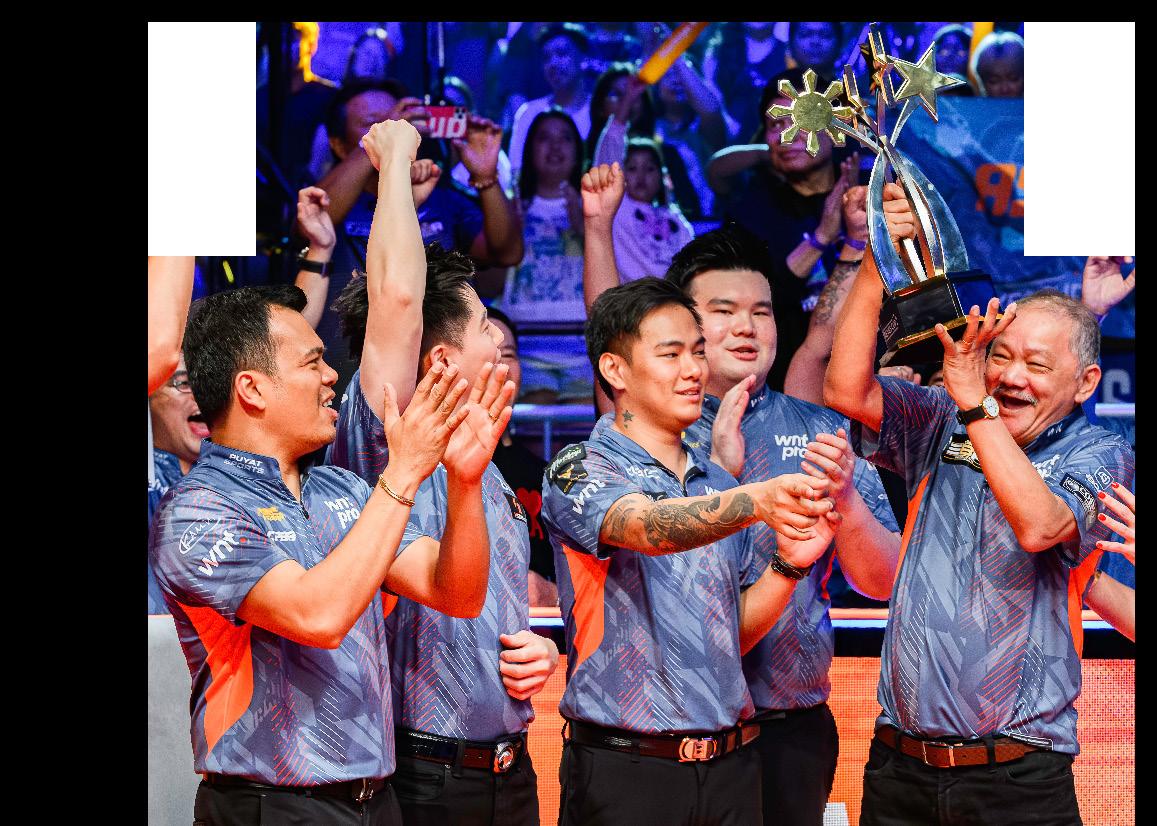








The Official Student Publication of De La Salle University - Senior High School Manila Campus

By Rianna Estacio
The University Student Government (USG) #TamaNaFees campaign failed to achieve its goal of attaining a 0-percent tuition fee increase (TFI) after the Multi-Sectoral Consultative Committee on Tuition and Fees (MSCCTF) announced a 3-percent TFI in a town hall meeting on February 19.

Present at the town hall meeting, held at the Velasco Building Room 207, were the Association of Faculty and Educators of De La Salle University (DLSU), Inc. (AFED), The De La Salle Employees Association (EA), the DLSU Administration, the USG, and the Parents of University Students Organization (PUSO).
on Page 4
NCR education sector demands proper wages, budget accountability
asallian educators and students from different universities across the National Capital Region (NCR) converged to protest proper wages for employees and accountability in government budget allocations in the “Kilos
Korapsyon, Kawalang Pananagutan” rally at
on January 31.
Organizers estimated 10,000 attendees, which was a follow-up to a media forum held at the De La Salle University's (DLSU) Pardo Hall on January 27, where academic stakeholders signed the Unity Statement Against Poverty, Corruption, and Impunity, signifying their initiative to demand accountability and justice within the education sector.
DLSU President Br. Bernard Oca FSC, along with other school representatives, including University of Santo Tomas (UST) Faculty Union President Emerito Gonzales and Association of Faculty and Educators of DLSU (AFED) President David Michael San Juan, led the signing of the statement.
Mark Anthony Salvador, a faculty member from the College of Liberal Arts and an assistant lecturer of Filipino at DLSU-Manila, said that lack of accountability has become normalized, citing the poor handling of social issues.
“We have to demand accountability from the government under the Marcos and Duterte regimes, which has resulted in the poor performance of our essential social services—education and healthcare,” Salvador said.
Continue on Page 2
The event commenced with a mass at 12 p.m. at the University of the PhilippinesManila (UPM), followed by the main program at 2 p.m. Mass organizations such as Anakbayan Vito Cruz, Akbayan Partylist, Magdalo, Tindig Pilipinas, students of different universities around Manila, and educators were seen at the rally.




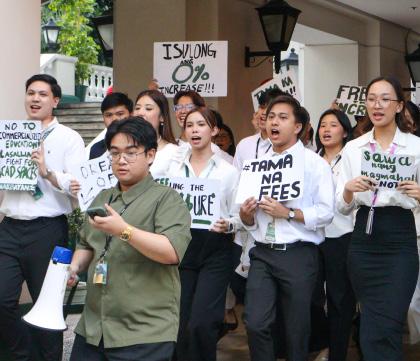

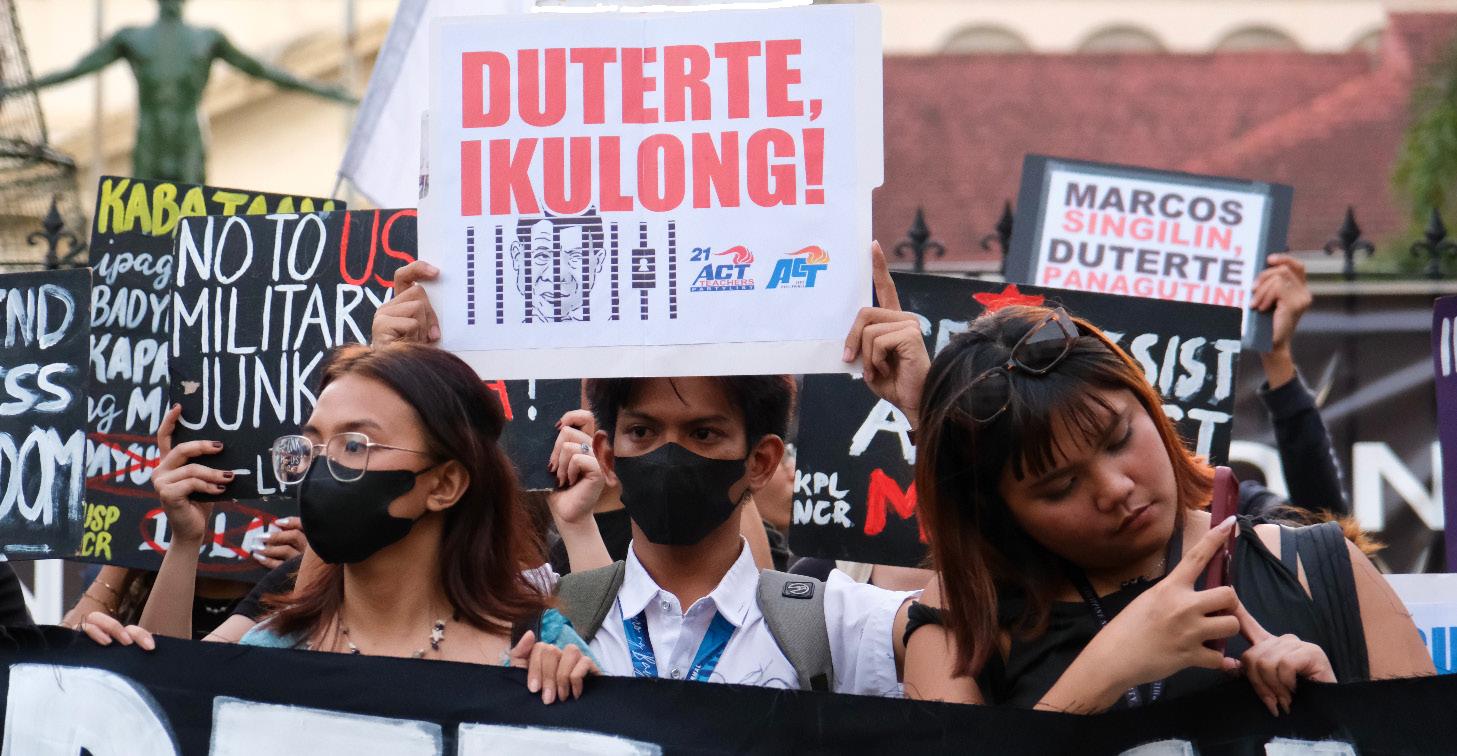
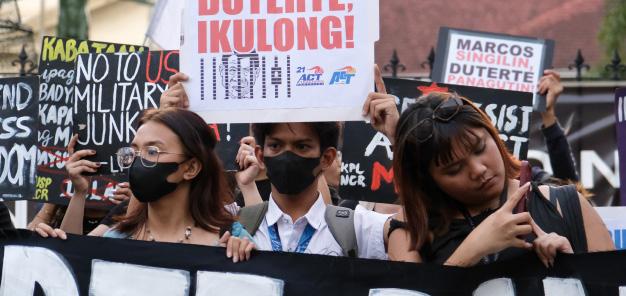
By Ivymae Macatiag
Progressive youth groups at the De La Salle University (DLSU) Manila campus yearned for justice for the extrajudicial killing (EJK) victims through various protests after the arrest of former President Rodrigo Duterte on March 11.
Duterte is detained in The Hague, Netherlands, after the International Criminal Court (ICC) issued a warrant of arrest for crimes against justice brought by the war on drugs campaign during his administration.
In a lightning rally on the same day of his arrest, Renee Bernas, vice chairperson of Anakbayan Vito Cruz, said that the community will never stop chasing justice until Duterte, including his alleged accomplices, is held accountable for the killings.
“Ngayon na ang hustisya ay unti-unti nang nagiging malinaw para sa lahat ng naging biktima ng kaniyang giyera kontra droga, hindi titigil ang pamayanang Lasalyano hangga’t hindi nasisigurado na mananagot si Duterte sa lahat ng kaniyang krimen at hindi tayo titigil sapagkat alam natin na nandiyan pa rin ang kaniyang anak na si Sara Duterte,” Bernas said.
Moreover, several rallies and mobilizations were organized after the arrest, such as the Black Friday Protest at DLSU and MultiSectoral Mobilization at Liwasang Bonifacio on March 14 and 28, respectively, where the victims’ families joined to share their stories.
During an interview with The Animo, a mother of an EJK victim expressed that the arrest made by the ICC gave them hope after years of constant battles for her child.
“Panahon na namin para maningil at mabigyang katarungan ang pagkamatay ng mga mahal namin sa buhay. Hindi lang ako—sa dami ng biktima, isa lang ako sa tumatayo para sa kanila,” the mother shared.
Furthermore, Vincent Halog, researcher of the Dahas Project—a running count of the drug-related killings in the Philippines—said in an EJK Forum held at DLSU last September 25, 2024, that they will keep on counting and releasing reports as long as the killings in the country persist.
The hearing for Duterte’s confirmation of charges is scheduled for September 23, following the pre-trial conducted a few days after he was held in custody.
From Page 1
By Matthew Rojales
Similarly, Nestor Reyes, a public school teacher and member of the Manila Public School Teacher Association, joined the rally to fight with his fellow educators.
When asked about his advocacy, Reyes told The Animo that he was determined to fight for better salaries for his fellow teachers and hold the government accountable for its negligence.
“I am here to fight for the salaries of my fellow teachers and fight to make the government accountable for their negligence toward their duties like healthcare, education, and almost all other social services,” he said.
Anakbayan Vice Chairwoman Renee Bernas, also an ID 121 political science major at DLSU, also shared that her advocacy at the rally
services, are not being given as rights. Instead, they are being privatized and used for personal gain by some people,” Bernas stated.
In addition, a student from De La Salle College of Saint Benilde (DLS-CSB) extended her invitation to students with the same advocacy of fighting for better governance and social services.
“We need to keep calm, organize and unite, and focus on serving the people,” she said.
The movement became a precursor to several other movements across Metro Manila, all calling for accountability and an end to corruption, with students urging for accessible, quality education free from
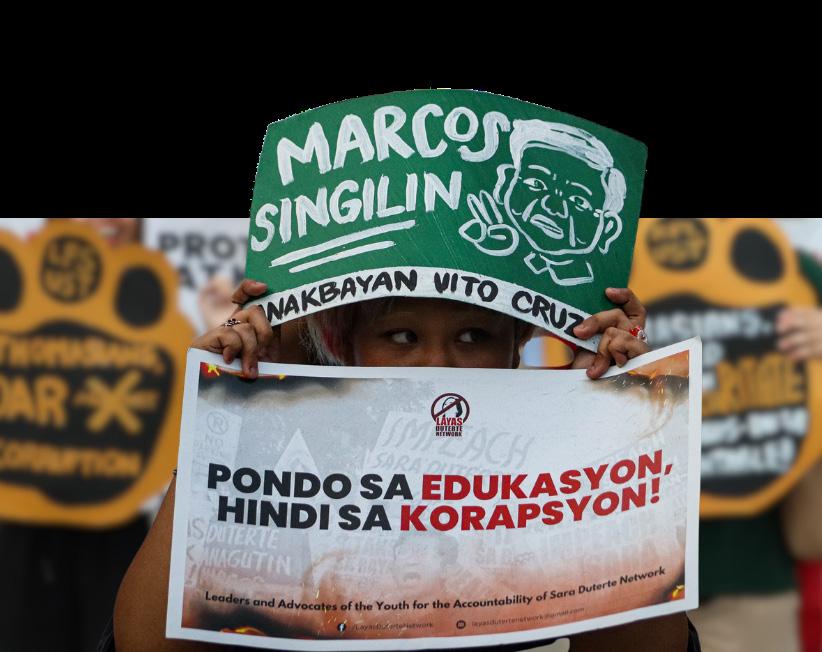
By Matthew Rojales
This marks the second consecutive time that the SHS Lasallian community favored the abstain option over the running vice presidential candidates following the Term 1 election, where abstentions garnered the most votes.
The DLSU-M SHS Commission on Student Elections (COMSELEC) released the Term 2 SC election results on their Facebook page on March 10, declaring no new candidates will join the council after none obtained the threshold of 50 percent plus one vote of the 694 votes.
Vice presidential candidates Maria Angela Basilio, Asher Bautista, and Ferdinand Liban failed to reach the required vote turnout,
as 33.7 percent of the voters favored abstention over the running candidates.
Meanwhile, Enzo Bertimy Adasa, the sole candidate for the position of PRO, also fell short of attaining the voter threshold, as 58.5 percent chose the abstain option.
The lack of qualities in a potential leader and the low feasibility of the presented platforms of the running candidates were cited as the reasons for the abstention of students.
In an interview with The Animo, COMSELEC Chairwoman Ryna Jade De Leon shared that she heeds potential future candidates
“Our student body deserves leaders who rise to the challenge, those who are willing to embody the values we hold dear. If you believe you have what it takes, step forward with courage, prove yourself worthy, and serve with the dedication our community deserves,” De Leon said.
As the 2025 midterm elections approach, careful candidate selection is further magnified as registered SHS students continue to practice their right to vote through the student council elections.
A survey released by Publicus Asia revealed that voters aged 18-24 and those who
are unemployed showed strong motivation for voting in the upcoming May elections.
The political consultancy firm also noted a high possibility of a strong voter turnout in the elections, emphasizing the need for voters to analyze each candidate closely and for candidates to connect with the masses more.
The upcoming Term 3 Special Elections will be the final election for the Academic Year 2024-2025 that will dictate the future leaders of the SHS department.
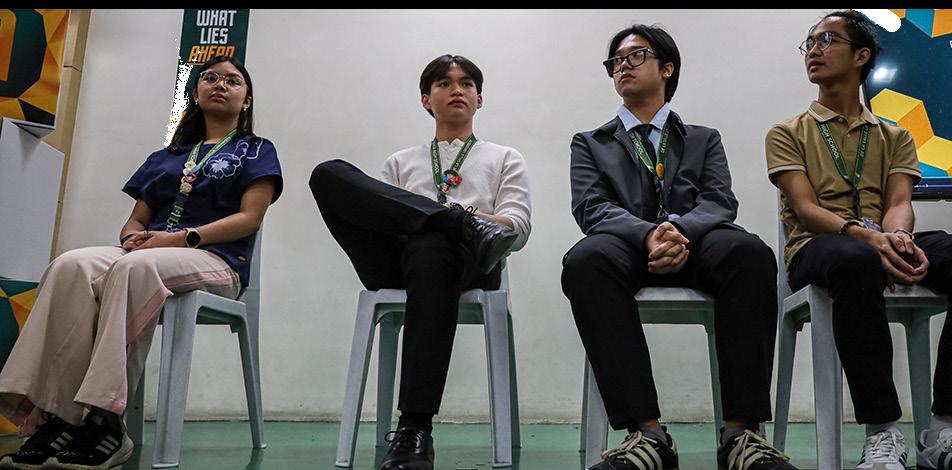

By Rianna Estacio
A task force has been inaugurated by the Department of Education (DepEd) to address the low-ranking performance of Filipino learners in the Programme for International Student Assessment (PISA), scheduled in the country from March 10 to May 2.
DepEd aims to boost its efforts in response to the 2022 PISA results, where the Philippines placed 77th out of 81 participating countries.
DepEd education program specialist and PISA focal person Alexander Sucalit Jr. noted that Filipino students are five to six years behind compared to higher-ranking countries, as the Philippines ranked 76th in mathematics and reading, 79th in science, and 63rd out of 64 countries in creative thinking.
To address this, DepEd Secretary Juan Edgardo “Sonny” Angara disclosed on October 6, 2024, that their task force gathered PISA-type exams and tapped experts to formulate new review questions to aid students.
Angara began leading the preparations for the 2025 PISA in mid-July 2024, supplementing existing science-focused programs similar to this year’s assessment and implementing 30-minute reading periods between classes to strengthen literacy skills in schools.
The education chief also promised they would provide the participating schools with the necessary preparations, including special classes, a tutoring program, and computers.
“For the 7,000 students who will participate, we will also provide each student with what they need. What food they need and the necessary support they will need for the exams,” Angara said in an interview with DZRH.
“I mean, this is like a championship game. We have to have them prepared,” Angara added.
However, on December 16, 2024, Angara said that DepEd’s budget cuts might delay preparations, and he is working with the Department of Budget and Management (DBM) to restore it as most funding was allocated toward the 2025 computerization program for public schools.
Meanwhile, the Second Congressional Commission on Education (EDCOM 2) expressed during the International Large-Scale Assessments (ILSAs) Online Symposium in September 2024 the need to focus on students’ foundational skills to not only raise the country’s ranking but also improve its education systems.
In line with this, World Bank Senior Education Specialist Diego Luna Bazaldua added that literacy and numeracy should be integrated into all subjects in the early grades, alongside adopting long-term commitments instead of short-term initiatives.
“Achieving substantial improvements in international assessments like PISA requires years of focused and sustained efforts,” Bazaldua said.
This year marks the country’s third participation in the PISA, held every three years by the Organization for Economic Co-operation and Development (OECD).
The results of the computer-based assessment are expected to be released in 2026.

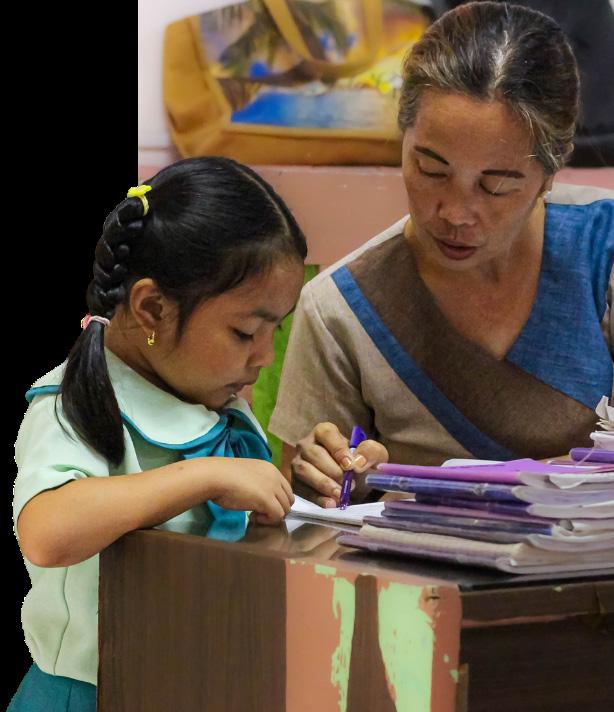
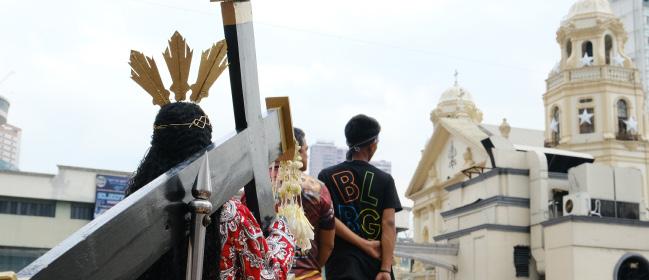
By Francis Cabrera
Lasallian devotees have expressed their concern over the modernization of the Feast of the Black Nazarene, emphasizing the importance of ensuring safety for the future of Traslacion.
Lorraine Bonifacio, an officer of De La Salle University Senior High School (DLSU SHS) iServe, which oversees church activities and other religious services at DLSU, called for the modernization of the feast, including live streaming and other virtual alternatives.
“As the event has grown in scale, so have the risks, including injuries and health emergencies due to the dense and chaotic crowd. When thoughtfully applied, modernization does not undermine devotion but protects it, allowing devotees to express their faith without unnecessary harm,” she said.
Bonifacio also believed that the Traslacion is a form of penance and an expression of gratitude for received blessings.
“Walking barefoot and enduring other discomforts mirrors the struggles of Jesus, which resonates with many Filipinos who face daily hardship. The Traslacion is an opportunity to deepen their connection with God and seek miracles,” Bonifacio said.
Moreover, Sofia Kim De Guia, a devotee from DLSU Senior High School, echoed the call for modernization of the feast but admitted that the country also lacks a budget.
“I suggest that the officials should have better control and policies made to avoid further accidents and injuries during the time of the feast,” De Guia said.
De Guia observed that some people attended the feast without a clear understanding of their intentions or the significance of the Black Nazarene, stressing that the Traslacion should remain a solemn and unified celebration.
“I think in terms of feasibility, we don’t have the capacity as of the moment to modernize the security measures during Traslacion because of budget constraints. But for me, we should really modernize not just the security measures but the overall safety and security of Traslacion while still instilling the traditional way of celebrating the Feast of Nazareno,” De Guia said.
De Guia also expressed her admiration for those who risk their lives to fulfill their faith and devotion.
“I commend them. I also hope that they contribute to making the celebration of Black Nazarene solemn as how it should be,” De Guia said.
On January 9, the National Disaster Risk Reduction and Management Council (NDRRMC) recorded 18.12 million attendees, lasting the procession for almost 21 hours, making it the longest since the pandemic.
'EDSA Revolution is not a normal day': Schools rally vs history revision bid
By Matthew Rojales
Various universities marched on the Epifanio de los Santos Avenue (EDSA) Highway in response to President Ferdinand Marcos Jr.’s declaration of the EDSA Revolution anniversary as a special working holiday to protest the supposed history-revising attempt on February 25.
The four-hour march was spearheaded by De La Salle University-Manila (DLSU-M) throughout EDSA, along with other universities such as Adamson University (ADU), Philippine Normal University (PNU), and the University of the Philippines (UP).
The EDSA Revolution holiday was established to commemorate the country’s freedom from Martial Law, allotting it as a day to celebrate the accomplishment. The supposed holiday, however, was not included in the list of holidays for the second year.
Despite its special working holiday status, several institutions, including DLSU, PNU, ADU, UP, University of Santo Tomas (UST), and St. Scholastica’s College, announced the suspension of classes in their universities.
DLSU, one of the first institutions to suspend classes at their universities, stated in a memorandum released by De La Salle Philippines (DLSP) on February 14 that the reason behind the suspension was an act to resist an attempt to erase the memory of our nation’s accomplishment in February 1986.
DLSU President Br. Bernard Oca FSC said in an interview with The Animo that the People Power Revolution's memory should be revered
and not be regarded as a regular day of the year.
“We have to remember EDSA. You cannot just say that it is an ordinary day—it is a day that we should celebrate, remember, and continue to fight for. We have to show that we are one people and that we are able to fight against all that is evil and corrupt,” he stated in the interview.
Moreover, several student government representatives from different universities united during the movement, voicing their disdain for Marcos' attempt to revise history.
Batch Vice President of the DLSU College of Business Cedric Perez urged fellow students to unite, embodying the idealogy that the youth are the nation's hope.
“Ang kabataan ang pag-asa ng bayan. It’s very timely and important now with the efforts of the president to rewrite history. The youth have to be more involved, especially politically, to showcase that we can fight and uphold the efforts of the past,” Perez stated.
Meanwhile, Keith Flint Peralta, a PNU Central Student Council officer, emphasized the youth's responsibility to uphold the memory of EDSA, adding that they should be the first line of defense against any attempt to forget its legacy.
Despite the President’s declaration, universities and their students continue to resist and combat the efforts of the government to rewrite the memory of the Philippines, gaining independence from Martial Law and the

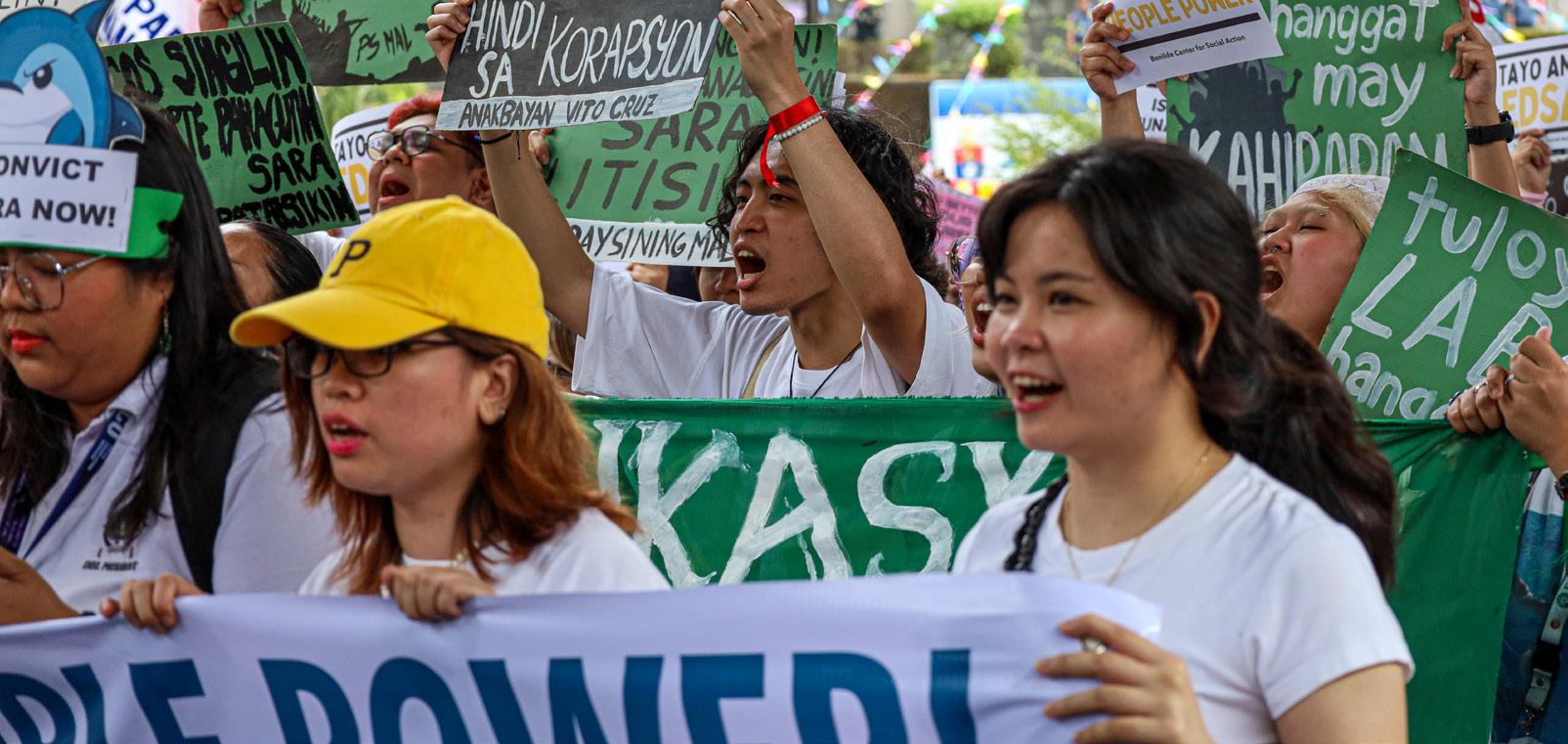
By Alesssandra Balasbas
The Department of Education (DepEd) released the 5-point agenda on November 19, 2024, which includes enabling the learning environment, teachers' welfare, learners' well-being, efficient learning delivery in all its forms, and a future-ready workforce.
The adjustment in the academic curriculum was based on one of the points made by President Ferdinand Marcos Jr. during his State of the Nation Address (SONA), highlighting the need for the Philippines' education system to be recalibrated to equip students with literacy skills, problem-solving abilities, and critical thinking.
As part of this, Angara stressed plans for the school year 2025-2026 to reduce five to six subjects from the current 17 subjects of the SHS curriculum to increase the employability
rate of students upon graduation.
“Lima ang core subjects na ire-require tapos maraming elective para ‘yung mga bata may freedom to choose [kung] anong gusto nila at makita ng lahat anong interest nila,” Angara said in a press conference on January 22.
The education chief also said that the Sports and Arts and Design Tracks will be moved under the academic track to reduce the core subjects required.
Moreover, DepEd released a 26-page online consultation packet of the “improved” SHS programs, available from April 4 to 11.
When asked about the views of the schools on the idea, Angara said that schools and teachers welcomed it and its
direction, affirming that the department’s findings of their experiences are valid.
Meanwhile, Angara said that the change will affect both public and private institutions offering SHS programs, including the DLSU SHS, which still administers the original curriculum.
“Ibibigay lang natin ang basic curriculum tapos bahala na ‘yung mga school kung ano ‘yung gusto nilang i-offer na electives, especially sa private sector,” the DepEd secretary pointed out.
The adjustment will test the adaptability of schools to the changes outlined in the new curriculum, including the reduction in the number of subjects students must take per semester.
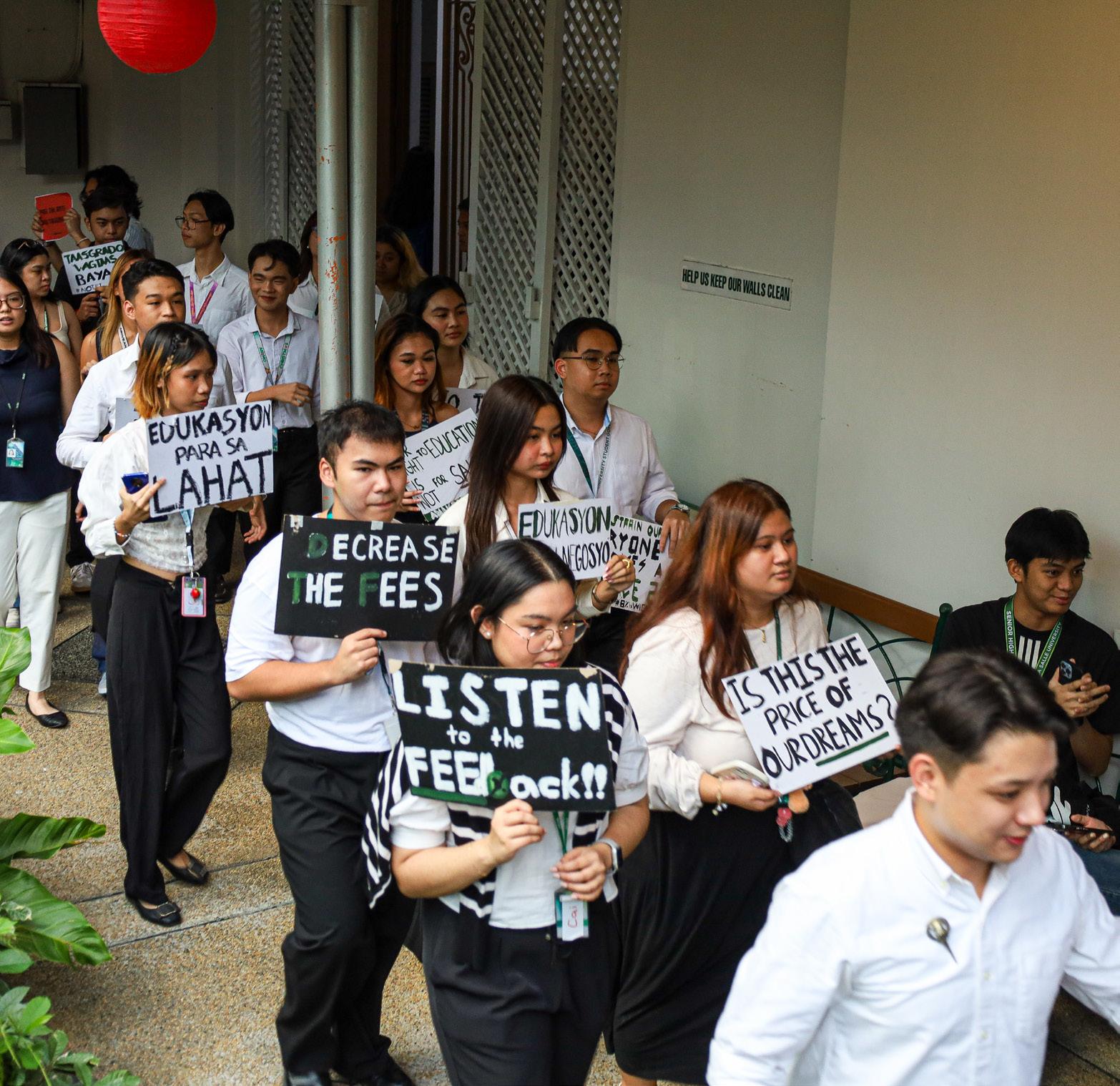
By Rianna Estacio
USG officials previously pleaded support from the Lasallian student body for their #TamaNaFees campaign, which advocates against TFI.
The USG’s efforts were focused on opposing the tuition increase after the AFED proposed an 8-percent increase, the EA presented a 6-percent increase, and the DLSU Administration put forth a 4.4-percent increase before the MSCCTF.
Moreover, the PUSO and USG both presented a proposal for a 0-percent increase to the MSCCTF.
The student-led government organized several activities from January 10 to 21, including a campus information booth, room-to-room discussions, and focus group discussions open to all students, with the campaign culminating in a Unity Walk on February 5.
In an exclusive interview with The Animo, USG President Ashley Francisco said the campaign aimed to inform Lasallians about the TFI’s impact and foster a collective sense of action among students and stakeholders.
“The TFI is not just a number—it reflects our shared values and priorities as a community. We hope to ignite discussions about the necessity of sustainable financial policies even after the campaign ends,” Francisco said.
Meanwhile, students from the University of Santo Tomas (UST), the University of the East (UE), and the National Teachers College (NTC) echoed similar calls, launching protests and petitions in January to oppose tuition fee increases at their institutions.
State universities and colleges (SUCs), including the University of the Philippines (UP), also criticized the Department of Budget and Management (DBM) for its reduced allocation, amounting to P122.16 billion, down from the P128.23 billion budget in 2023.
The 3-percent TFI is set to be implemented for the Academic Year (AY) 2025-2026, and it is only awaiting the approval of the Commission on Higher Education (CHED) and DLSU President Br. Bernard Oca FSC.
By Julianne Lao



A survey by The Animo on the participation of students in the 2025 senatorial elections revealed that 72.7 percent of Grade 12 DLSU students would cast their votes, while 27.3 percent would not.
JC Cammayo, an ID 123 Humanities and Social Sciences (HUMSS) student, shared her sympathy for individuals who lack sufficient knowledge to make informed electoral decisions and are vulnerable to political exploitation.
“I once heard (the phrase), ‘kung kanino mas malaki,’ which made me realize how many people lack knowledge about politics and the candidates running for office. For this reason, I am motivated, as an informed student and citizen, to vote and encourage others to make informed and wise decisions in elections,” Cammayo said.
In contrast, John Kyle Mendoza, another ID 123 HUMSS student, cited his family’s conservativeness as his reason for not participating in the senatorial election. Mendoza, however, believes that the elections are essential to shaping the country’s future and would vote if given the chance.
plans and projects.
DLSU-M SHS SC President Avah Marzan revealed that the council plans to release relevant information about the senatorial elections online to help the Lasallian community have an educated vote in the coming polls.
The Animo has also established a dedicated segment— Archer's Vanguard—to deliver critical and credible information to the Lasallian community.
Archer’s Vanguard is set to release a mock senatorial election on April 25, providing eligible Lasallian voters a chance to choose from 64 out of the original 66 senatorial candidates listed by the Commission on Elections (Comelec) for the 2025 midterm elections.
Senatorial candidates Manoy Willbert Lee and Willie Tan Ong previously withdrew from the senatorial race, citing a lack of campaign machinery and health concerns, respectively.



Moreover, the DLSU-M SHS Student Council (SC) has announced plans to instill voter education among the Lasallian student body during the Project Student Council Assessment of Leadership and Effectiveness (SCALE) held on March 21.
Project SCALE is an annual event that aims to foster an atmosphere of discussion between the student body and the council while also serving as a platform to announce
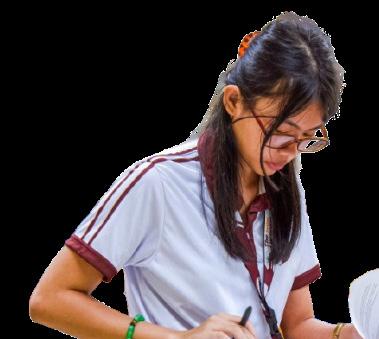
Meanwhile, a Pulse Asia survey of over 2,400 randomly selected Filipino voters, conducted from March 23 to 29, showed Senator Christopher “Bong” Go leading the senatorial race at 61.9 percent, followed by ACT-CIS Representative Erwin Tulfo at 51.1 percent and Senator Ronald “Bato” dela Rosa at 48.7 percent.
As the senatorial elections draw near, challenges linger as political literacy and familial influence continue to shape Lasallian voters’ voting behaviors, and the need to make informed decisions becomes more crucial to ensure the shaping of the nation’s future.
By Francis Cabrera
Various student publications convened at this year’s Para sa Bayan at Lasalyano (BayLayn), hosted by Ang Pahayagang Plaridel, to compete in workshops promoting responsible use of online journalism, held at the Teresa Yuchengco Auditorium on April 5.
Ang Pahayagang Plaridel, De La Salle University’s (DLSU) Filipino collegiate publication, marked the 21st year of BayLayn with the theme “Pagyakap sa Pagbabago: Balanseng Paggamit ng Online Media Trends,” calling for the ethical use of digital journalism.
Plaridel Editor-in-Chief Kyla Mojares emphasized that campus journalists can improve their research strategies, critical analysis, and effective news reporting through workshops and competitions.
“Gayundin, mas nalilinang ang kanilang husay sapagkat pinangungunahan ito ng mga batikang personalidad sa midya na nagtuturo ng estratehiya sa pagsasaliksik, masusing pagsusuri ng impormasyon, at epektibong paglalahad ng balita,” Mojares said.
The event featured keynote journalism speakers, namely ABS-CBN News Deputy Editor Anjo Bagaoisan and independent journalist Mark Villaluna, to enlighten the campus journalists about other journalism means and their ethical use.
Plaridel Managing Editor Hanali Septimo stated that BayLayn had been continuously organized to enhance campus journalists’ minds and journalistic skills through its press conference competitions and workshops.
“Nakatutulong ang BayLayn sa mga mamamahayag dahil binubuo ito ng mga workshop at kompetisyon sa iba’t ibang kategorya. Mayroon ding dalawang pangunahing pananalita o lecture na madalas ay ibinibigay ng mga beteranong mamamahayag,” Septimo said.
Septimo also emphasized that responsible online journalism can be achieved if it is anchored in ethical journalism and that even though today’s journalism is done in different styles, publicizing false information should be avoided, one of the problems the collegiate publication recognizes in modern journalism.
“May ilang sumusunod sa paggawa ng trends upang makahikayat ng mga mambabasa, subalit may pagkakataong hindi naisasalang-alang ang etika ng pamamahayag,” Septimo said.
Jamillah Moira, a BayLayn participant and a campus journalist from Bulacan, shared with The Animo that she gained valuable insights from the workshops, citing the significance of social media usage in journalism.
“Very easy, mag-ulat ng katotohanan para sa kamalayan ng komunidad. I-angat ang mga boses na marapat makarating sa masa,” Moira said.
Moira also highlighted that campus journalists are accountable for delivering the truth to the community, not only within the campus but also to the public.
The collegiate publication then stated that BayLayn is gearing up for future events to highlight further the significance of battling against misinformation for the coming midterm elections and the next presidential elections.
Plaridel emphasized that BayLayn is not solely focused on improving campus journalism but on promoting the Filipino language as a powerful, investigative, and liberating tool in
of
and
There is no theft more damning than a stolen democracy—one taken not by force, but by the silence of a people who have long stopped believing in the possibility of change.
In the shadow of the upcoming 2025 Senatorial Elections, the trend of political dynasties, familiar names, and popularity contests disguised as polls is grotesquely reminiscent of campus elections within institutions like De La Salle University (DLSU). In the Philippines, elections have become a theatrical performance, where power is bought, votes are traded, and the cycle of corruption continues unchallenged. The illusion of choice lingers, but the truth is clear: those with wealth and influence have already decided the outcome. From national elections with nuisance candidates and political dynasties crawling with systemic corruption and excessive spending, to campus elections with empty positions and low Miting de Avance and voter turnout, voters, especially students, are left disillusioned and trapped in a cycle of indifference.
And in the face of this rigged system, silence prevails.
Filipinos can only expect a crash and burn, paralleling students left unled in their school hallways. For student council elections, a similar narrative is spun. The turnout for the amassed number of votes in the recent appointment of student leaders at DLSU can only complete barely half of its population, with engagement only spiraling for uninterested students.
What could be expected when, on the national scale billions are spent and poured into efforts in each election season to ensure the number of votes redeemed for a single, likely unqualified candidate. The apathetic Filipinos end up with no choice.
Nationwide, the cycle of stagnation and indifference within those in the seats of power has proved one thing— the people are tired and their standards have lowered. Campaigning has snuck into unwarranted advertisements
and entertainment like the Metro Manila Film Festival allowing senatorial candidates to present the awards on live television. With the people overwhelmed with the basic necessities being at an all-time high, their efforts and any possible empathy for the nation’s problems have been exhausted. Competence has long been forgotten amidst personal crises brought by incapable leaders.
When the people believe that their votes cannot enact change, they settle for the most familiar name on the ballot— the names echoed by million-peso adverts.
But when popularity and wealth overpower the low standards within Filipino voters, disinformation takes the stage as democracy’s greatest demise. Disinformation thrives, manipulating the electorate through social media, a supposed herald of free speech, and turning legitimate discourse into a battleground of deceit. Troll farms rewrite history, vilify opposition figures, and rebrand the same corrupt politicians as champions of progress, while burying under all the clout the actual reformists.
In universities, the same tactics seep in: just as Filipinos have been
conditioned to see elections as a spectacle rather than an opportunity for change, students, too, have cometo view student leadership as a popularity contest rather than a vehicle for meaningful governance.
Thus, when national leaders use the media to distort reality, this lack of transparency bleeds into universities and high schools filled with impressionable students— questioning whether their votes matter when decision-making remains hidden behind closed doors. So then, when the youth convince themselves that their votes and voices are insignificant, how will democracy prevail?
With apathy ingrained in both national and campus politics, students are left without a guiding light to reassure them of change. Nationally, they face a future dictated by leaders who prioritize personal and political gain over the people’s welfare. Within schools, disengaged student leaders, if any at all, fail to address pressing concerns, such as the inaccessibility of education due to tuition fee hikes. What the nation will have is a disempowered generation, resigned to a broken system, and desensitized towards cycles of inaction and indifference to what endangers the nation. What will be left of the rest of the Filipino people when the youth succumb to political apathy? Who then will hold the unfit, the unjust, and the unworthy accountable?
If young people continue to see governance as futile, the country will be left apathetic with leaders who do not represent them, elected by a system designed to silence them.
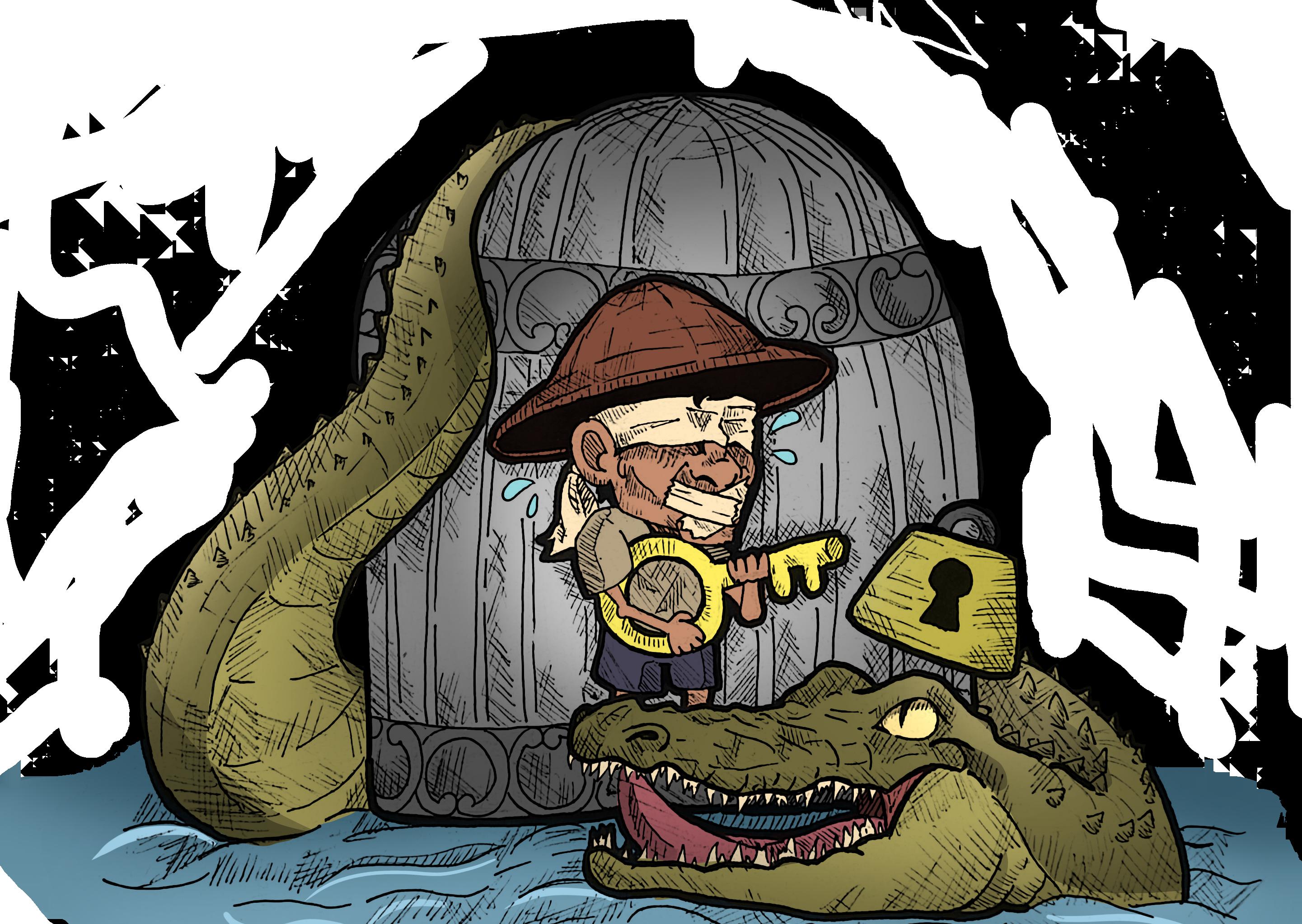

By Kobie Guillermo
The UAAP season has ended, leaving participating universities to cope with the sting of defeat. Amidst the usual rivalries, an oftenheard remark retaliates among the country’s “top” universities:
‘‘
“Bakit,
What began as a humorous banter presents more than just a bitter end to a sports competition: a harsh reality that the country’s higher education system is sustained only by misguided positivities and illusions of global competency through these rankings.
The global placements they take pride in speak nothing but complacency. Unlike previous years when the country secured spots in the lower 1000s, the Philippines drastically fell off on the latest Times Higher Education (THE) University Ranking. Ateneo De Manila University (ADMU) dropped into the lower 1200s, and the University of the Philippines now ranks in the lower 1500s. Meanwhile, neighboring countries of Malaysia and Taiwan secured 14 spots within the top 500 bracket, with public universities leading the standings.
For yet another year, the Philippines finds itself trailing embarrassingly behind the higher education systems of other Southeast Asian countries, which is evident in the barren decline of our higher education institutions (HEIs) in global standings. While the Commission on Higher Education (CHED) celebrates this ‘victory’, it only highlights cycles of neglect in the higher education incomparable to what should be our peers.
This year, budget cuts for state universities and colleges (SUCs) exceeded more than ₱14 billion under the approved 2025 National Expenditure Program (NEP). In contrast, Malaysia has raised an additional RM1.7 billion for higher education, equivalent to over ₱22.6 billion. Education holds the largest allocation in both countries’ 2025 National Budgets, but the drastic difference from the dominance of private universities in the Philippines only highlights privilege in quality education and the decline in global competency among publicly-funded colleges and universities in the country.
Even with billions allocated to CHED, these funds are underutilized in addressing pressing needs. Between 2019 and 2022, CHED reportedly left over a staggering ₱8 billion in unused funds following the closure of the Philippine California Advanced Research Institutes (PCARI) in 2020. The possible opportunities that these funds could have been repurposed for, were instead used as damage control for PICARI’s failed implementation. Yet in spite of these deficiencies, CHED Chairman J. Prospero “Popoy” De Vera III still believes that the results of the global rankings mark an “outstanding” milestone for Philippine HEIs.
While our leaders preach hollow victories, we are left to contend with their mismanagement and funding priorities. We remain far from being the star in the global arena of academic excellence. Only by investing in long-term solutions—expanding scholarship opportunities, accessible research facilities, and improving school environments—can we hope to break this cycle. But if we keep tearing each other down over our shortcomings, we will remain a nation with world-class aspirations weighed down by third-world priorities—while those at the top revel in their mediocrity.

By Zyra Rondael
Waste piles up while excuses stack higher as city leaders toss the blame instead of the trash.
Manila’s garbage crisis has taken center stage. As uncollected waste clogs streets and poisons neighborhoods, the nation’s capital has turned into a grim showcase of administrative neglect. Amidst the stench of decay and growing health risks, one thing remains remarkably clear: Manila’s leader seems more skilled at tossing blame than trash. Mayor Honey Lacuna’s administration is under fire for failing to manage the city’s waste—a failure that reflects not just mismanagement, but a betrayal of public trust.
Despite its substantial budget, the Manila government neglected the basics, failing to allocate resources effectively for city essentials like garbage collection. Instead of rolling up their sleeves, the administration has pointed fingers at the Leonel Waste Management Corporation, accusing the company of abandoning its duties at the end of its contract. But Leonel has flipped the script, revealing that the city owes them a staggering ₱561.44 million in unpaid dues.
This is not just a financial faux pas; it is the rotten core of a system that has left Manila buried in its own filth.
The consequences of this mess extend far beyond inconvenience. Students and residents along Taft Avenue have been caught in the crossfire, having to now navigate streets lined with uncollected garbage. As these piles of waste fester under the sun, the stench and unsanitary conditions expose passersby to serious health risks.
Recent reports highlight the severity of the issue. The streets of Taft are littered with uncollected waste, sparking frustration among commuters and residents alike. Manila’s youth, who now have to dodge trash heaps on their way to school, deserve better than this “garbage-in, garbage-out” approach to governance. The situation is not just messy, it is hazardous: turning

streets into breeding grounds for disease and a damning symbol of misplaced priorities.
The administration’s attempt to sweep accountability under the rug is even more infuriating. Rather than own up to their financial mismanagement, they deflected blame onto Leonel, calling out the company’s supposed failures while disregarding their own refusal to settle past dues or prepare for contingencies. With a reported ₱23.2-billion budget in 2024, the administration should have no excuse for neglecting essential services, yet it still failed to allocate the necessary funds for waste management. This is not just a blot on their record, but a stain on Manila’s streets and its future.
Manila’s crisis is not just about overflowing trash: it is a city suffocating under the weight of its own neglect. The administration chose to turn a blind eye while the city rotted from the inside out. Students, who should be focusing on their futures, are left to navigate a polluted, decaying environment.
If Mayor Lacuna’s administration continues to avoid responsibility, it will not just be the streets buried in waste; it will be the public’s trust in their leadership, confidence in their governance, and their hope for a better future.
The city cannot afford any more inaction. Manila is on the brink of a full-scale public health crisis. If nothing changes, it

COMMENTARY
By Zyra Rondael
Drifting in a deluge of delays, students are left to weather the storm of reactive suspensions that drown out the need for real solutions.
For students across Manila, the sound of rainfall often brings a familiar uncertainty: the agonizing wait for class suspensions. What should be a straightforward decision often spirals into a tempest of anxiety: students and parents frantically refreshing for news updates, holding their breath until the eleventh hour, even as floodwaters rise, streets become impassable, and the threat of being stranded or caught in unsafe conditions looms over them.
Manila Mayor Honey Lacuna proposed the importance of “data-driven” class suspension announcements. While relying on metrics may seem like a clear path through murky waters, this perspective often overlooks the storm brewing on the ground. Students wade through flooded streets and navigate perilous commutes—harrowing realities that spreadsheets and forecasts fail to encapsulate; no algorithm can measure the fear of crossing a chest-deep flood or the exhaustion of braving hours-long traffic just to reach school safely. By focusing solely on numbers, local governments risk drowning out the voices of the very people they are supposed to protect.
This relentless cycle is more than just an inconvenience–it is a damning reflection of a government floundering in the face of escalating weather crises, offering quick fixes that crumble under pressure instead of building solutions that withstand the test of time.
Class suspensions, though necessary when calamities strike, are little more than a temporary umbrella against a flood of systemic failures. Streets remain submerged, homes turn into islands, and power outages leave students in the dark—literally
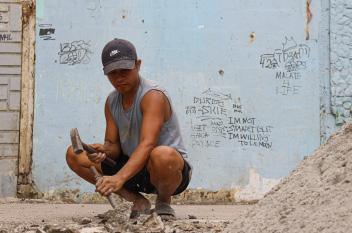
life rafts, but without real lasting reform, students are still left to sink or swim. Until long-term solutions replace these knee-jerk responses, students will remain at the mercy of every storm that passes.
The government fails to address the root causes of our fragility in the face of extreme weather: inadequate disaster preparedness and a lack of long-term climate resilience strategies. Instead, the weight of adaptation is thrust onto students’ shoulders, who must tread through disrupted schedules, academic backlogs, and the rising tide of mental and physical exhaustion, all while the system continues to stay afloat on band-aid solutions.
This addiction to quick fixes unmasks a deeper fault in our governance: a culture of waiting, where solutions are summoned only after disasters knock at the door. Data may draw the map, but it cannot steer Manila away from its calamity response crisis.
‘‘Only urgent action can prevent the city from being swept under by its own neglect.
It is leadership stuck in reverse: patching cracks while ignoring the foundation. Instead of steering towards progress and preparedness, this approach strands the nation in a perpetual holding pattern—waiting for crises to pass, but never preventing them from returning.
The storms are intensifying, and waiting for the rain to pass is no longer an option. If our leaders continue to rely on the flimsy raft of reactive suspensions, they risk leaving students adrift in a sea of systemic neglect.
BUT I’M WILLING TO LEARN. Rommel Bisinan, 24, chisels down slabs of concrete debris at a small, demolished lot along Fidel A. Reyes street on January 30, 2025. Once a dishwasher for four years before being hired in construction, he started working after graduating elementary school. The declining access of Filipinos to education have resulted in lower literacy and schooling rates in the country. Despite this, the choice on whether to continue their education or not becomes an easy one. While schools can only provide salutations on paper, occupations provide wealth on banknotes—even if the most it can do is put food on the table.
This religious festival is more than just a mass procession: it is a reflection of a nation’s struggles and its government’s inability to address them.
The Traslacion, or the Feast of the Black Nazarene, is a highly anticipated annual mass procession commemorating the transfer of the life-sized image of Jesus Christ bearing a cross from a church in Intramuros to its present location in Quiapo Church. Every year, thousands of Nazareno devotees brave exhaustion and injury, traveling kilometers in hopes of touching the sacred image. For the devotees, it is an act of faith; a plea for miracles, a desperate grasp of hope. However, beneath the devotion, this mass procession mirrors the nation’s reliance on faith as a remedy for the state’s neglect: our complete endurance in the face of suffering, and the failure of our leaders to address systemic problems. We should not be forced to turn to religion for what our government refuses to provide.
We hear simple prayers and pleas: not for excess or grandeur, but for the most basic necessities. Healthcare,

To the Editors,

At the start of the school year, I recognized The Animo's coverage in and out of the campus, from tackling the local and national issues for the youth. With my first year in Senior High School as a Grade 11 Lasallian, I can extend my warmest appreciation for your publication as it continues to strive, with capturing the truth through steadfast purpose and integrity through what I see, read, and hear from the publication.
However, with the upcoming midterm elections and various information disorders that afflict the dissemination of electoral news, how would you ensure your publication’s involvement in voter education that advocates for the truth? As I have recently reached voting age, I am a bit unsure of whom to vote for, so I am hoping for some guidance, as there is little to no other aid available within the school. Thank you for taking the time to read this. I would appreciate any response.
Warmest regards, Carlos (alias)

By Maegan Paragua
When privilege becomes the prerequisite for free education, those who need it the most are left in the dark.
The recent Department of Science and Technology (DOST) scholarship application process has once again sparked discourse about what it means to be “deserving” of free education. The qualifications, while undeniably rewarding academic excellence, raise the question: Is meritocracy truly fair, or does it merely perpetuate inequality?
Meritocracy is the belief that success is earned solely through hard work— comforting, but delusional. The truth is, opportunities are not just there for anyone’s taking. The reality stands that merit merely reflects the privileges and resources that a person—a student—has access to.
Students from more well-off backgrounds have clear advantages: private tutors, stable home environments, private schooling, advanced learning materials, extracurricular opportunities, and financial stability. These advantages create a performance gap between those who have them and those without. When scholarship opportunities determine merit through academic performance alone, they inadvertently favor the privileged: those who have the means to excel.
Take the Archer Achiever scholarship within De La Salle University (DLSU), one of the few that award fully waived tuition. Students from disadvantaged backgrounds, though brimming with potential, rise above systemic obstacles that many of their privileged peers will never encounter, marking the odds against them. Unstable home environments, financial insecurity, and limited access to academic resources—not excuses, but barriers that push the underprivileged down in a system that does not take them into account. Yet alongside these scholars, DLSU Senior High School students, who are typically exempted from the DCAT and ranked by their grades, also secure spots among the top 100 scorers and are still awarded these scholarships. This raises questions about whether the scholarship’s intent— to uplift those who excel against systemic disadvantages—is being fully realized.
‘‘The question remains: What happens to students who aren’t academically ‘brilliant’ but are equally, if not more, in need of financial assistance?
Measuring the worth of a student who overcomes systemic barriers with resilience and determination challenges our perceptions on who is truly “deserving” of a chance at education. Rooted in rigid meritocratic ideals, the current major scholarship systems are neither accessible nor equitable. Though there are financial-based scholarships, they are usually mere partial scholarships, with students still affected by issues such as tuition fee increases and miscellaneous fees. To create a truly inclusive system within reach for each and every Filipino student to have a chance, we must move beyond merit as the sole criterion, and apply an approach that accounts for the needs, potential, and context in which a student’s achievements were made. Only when scholarships stop being a measure of privilege disguised as merit and start being instruments of equity will they truly fulfill their purpose. Until then, the dream of equal access to education remains just that—a dream, leaving the disadvantaged in the shadows of lost potential.

To Carlos,

I am filled with gratitude for your appreciation of how The Animo has aided in bridging the gap between you and the campus, as well as the country. With this year’s publication theme of Horizon, we plan to further convey the lives of the Filipino people and the state of the country to the awareness of the youth. Undergoing a rigorous process is a must in our output of writing, photojournalism, broadcasting, and other forms of media. We advocate for the truth by correcting misleading information, posting factual data, and lived occurrences that cannot be distorted. Combatting these is not easy, yet we must work together not to forget our narrative and coherent responsibility as Filipinos, and that includes you.
Answering your question, the publication’s responsibility this electoral season is to direct you to verified reports from the running candidates and any Comelecrelated news. As a voter, it is not within our jurisdiction to force your vote, but to guide you to the needed materials to cast a ballot—one that will benefit the nation and align with advocacies that do not distinguish our constitutional rights. With this year’s implementation of Archer’s Vanguard: Voice of the Polls—The Animo’s electoral segment—we have pledged to post voting guidelines, candidate profiles, helpful advice, and timely updates at your pace. We are also holding a mock election for the senior high school student body of DLSU Manila to help first-time voters like you make these influential decisions. After all, you are the one responsible and capable of changing the nation’s tomorrow.
Sincerely,
Maurin Isabel H. Mateo Editor-in-Chief
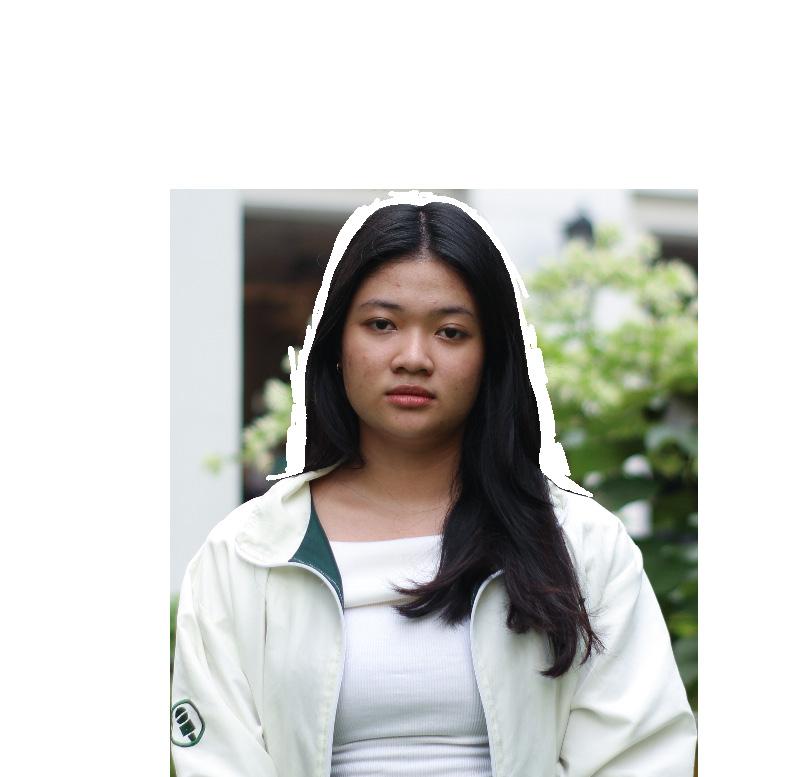
By Martheena Genobili
When society turns a blind eye to the cracks in its education system, those cracks become chasms—and the people continue to suffer.
The recent Programme for International Student Assessment (PISA) results once again placed the Philippines in the bottom four among 64 countries in creative thinking. These numbers are more than just statistics; they are a reflection of the dismal state of education in our country. With the recent budget cuts, misallocation of crucial resources, and now a transition to new leadership, what will become of our education system?
While this should have served as a wake-up call, the government instead responded with a ₱12-billion budget cut. This came amidst overcrowded classrooms, deteriorating infrastructure, overworked and underpaid teachers, and students severely left behind on the world stage. Students lacking in basic subject competencies and our inability to keep up with global standards raise pressing concerns about the quality of our education:

By Martheena Genobili
education, food, resources—the bare minimum that the government should be addressing. This is not a prayer for divine intervention. It is for an escape from systemic failure. Are Filipinos truly religious, or have we simply become used to a government that does not care? The people have grown too reliant on miracles because their government continuously fails to address their struggles.
Yet their pleas do not stop strongman politics from exploiting religious devotion as a tool for control. Leaders wrap themselves in faith and take advantage of people’s religious vulnerability, positioning themselves as chosen figures and the nation’s savior, but failing to enact systemic reform and accountability. They only further reinforce the idea that resilience and suffering are the answers to their hardships.
When faith becomes the people’s primary source of hope and aid, it highlights the state’s inability to fulfill its promises.
efforts on test-takers alone, but for this he has already drawn flak, owing to how such efforts could lead to inflated results that fail to reflect the true state of Philippine education.
Education is the backbone of any nation. Without significant improvements, student competency will only continue to deteriorate, and the country along with it. We call for real, urgent action. We can only progress when we prioritize sufficient funding, invest in infrastructure and teacher training, implement transparent accountability systems, and ensure that reforms are inclusive, not just performative. The youth deserve more than band-aid fixes and empty promises.
We cannot keep settling, again and again, for a weak and broken education system. To neglect education is to sabotage a nation’s future. The youth deserve a system that believes in them, invests in them, and prepares them. Should we continue down this path, we risk condemning not just our children to a future of neglect—but the Philippines itself to a future in jeopardy.
A system of education that expects students to adapt continuously, yet one that remains wholly ineffective in addressing its core issues.
How can a nation expect its youth to excel in these conditions?
These were only made worse by the poor leadership of former DepEd Secretary and Vice President Sara Duterte. Under her watch, billions were unused and misallocated. Thousands of laptops were left undelivered, and only ₱2.75 billion of the ₱11.36 billion allocated for information and communication technology was disbursed in 2023. This mismanagement drained crucial resources meant to uplift learners and support educators.
With Sonny Angara now at the wheel, the department’s new management must combat these longstanding issues with systemic reforms that uplift all Filipino learners, not just those participating in international assessments. One of Angara’s early plans was to focus PISA preparation
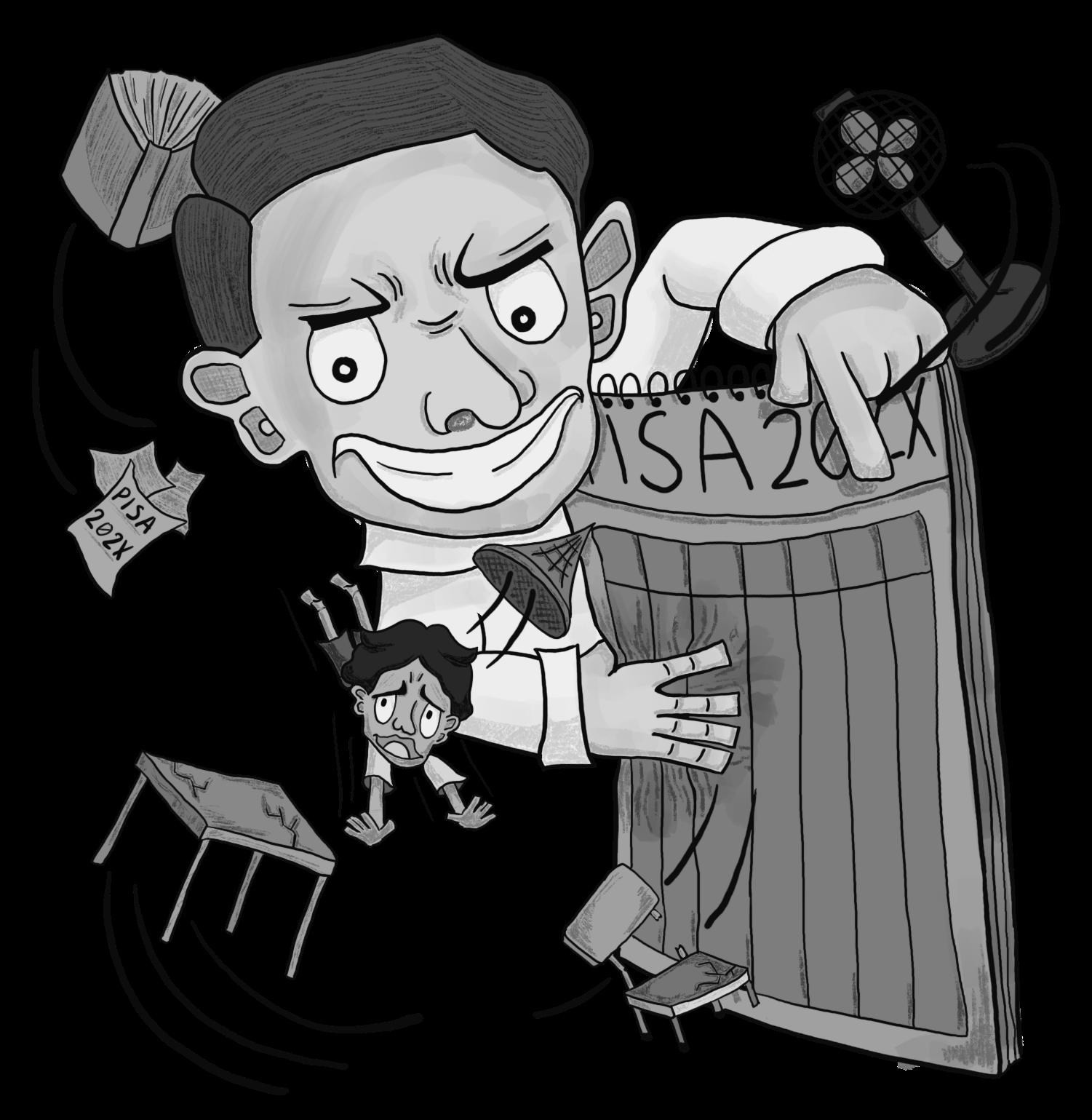
Faith alone will not heal the sick, feed the hungry, and educate the poor.
These are not miracles: they are the basics of human rights that should be boosted by government initiatives, not left to prayers and miracles. Religion should not be a silver bullet for systemic failure; it should empower us to make wise decisions for our salvation. Our faith should empower us, not pacify us. Instead of accepting suffering as a test of devotion, we should demand better from our leaders. The true miracle will not come from waiting and romanticizing suffering. It will come from action, from holding those in power accountable, and from refusing to let faith be a diversion from the justice we deserve.
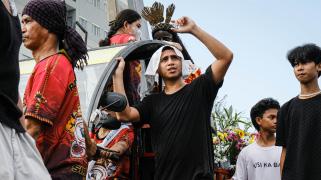


By Kobie Guillermo & Bridget Manuel

By Maegan Paragua
What was once a legacy built on the promise of equally bright opportunities for all, has now become anything but.
De La Salle University (DLSU) is set to implement a staggering 3% tuition fee increase for the 20252026 academic year as a response to rising inflation, infrastructure improvement, and declining enrollment. While DLSU is known for its quality education and academically competitive landscape, it is equally infamous for its inaccessibility due to the expensive cost of its education. For many students, this larger charge adds insult to injury— that of the impenetrable divide between quality education and those in need of it.
Rising tuition fees have been a constant symptom of the university for the past few years. It places a heavy financial burden on students and their families, raising the question of where DLSU’s real priorities lie: on long-term financial strategies, or on inclusivity, upon which the school’s values are built.
When the university first announced a 4% tuition increase back in 2020, it heralded the beginning of constant additions to academic expenses. This became the catalyst for what has now become an annual norm for the university. Although insignificant to many, its cumulative effect is felt the most by those not from wealthy backgrounds. For students who heavily rely on financial aid, these additional costs could mean fewer scholarship slots and even less financial assistance, further dimming the light of a once-bright future.
While the expertise of its faculty and the prestige it holds may justify the cost, the question stands: how much more can DLSU students bear? Quality education is becoming increasingly inaccessible, with institutions like La Salle leading this example.
Education must remain a right, not a privilege. Yet, how can we demand transparency and question the supposed benefits that these increases truly bring when we have an administration unwilling to listen? True accountability requires a mutual give-and-take relationship between stakeholders and students—only then can we not compromise
the value of our education. Otherwise, the continuously rising tuition costs speaks to a profit-driven agenda rather than a student-centered one. The consequences of these tuition fee increases do not just end at the gates of DLSU. We must understand what this could mean for students across the country. An institution that abandons the values of its patron is nothing more than a corporate scheme. It is imperative that we, now more than ever, remember the principles St. John Baptist de la Salle dedicated his life to.
‘‘
His legacy, built on the fight for accessible quality education for all, must not be lost—neither to those at the head of the table, nor from us.

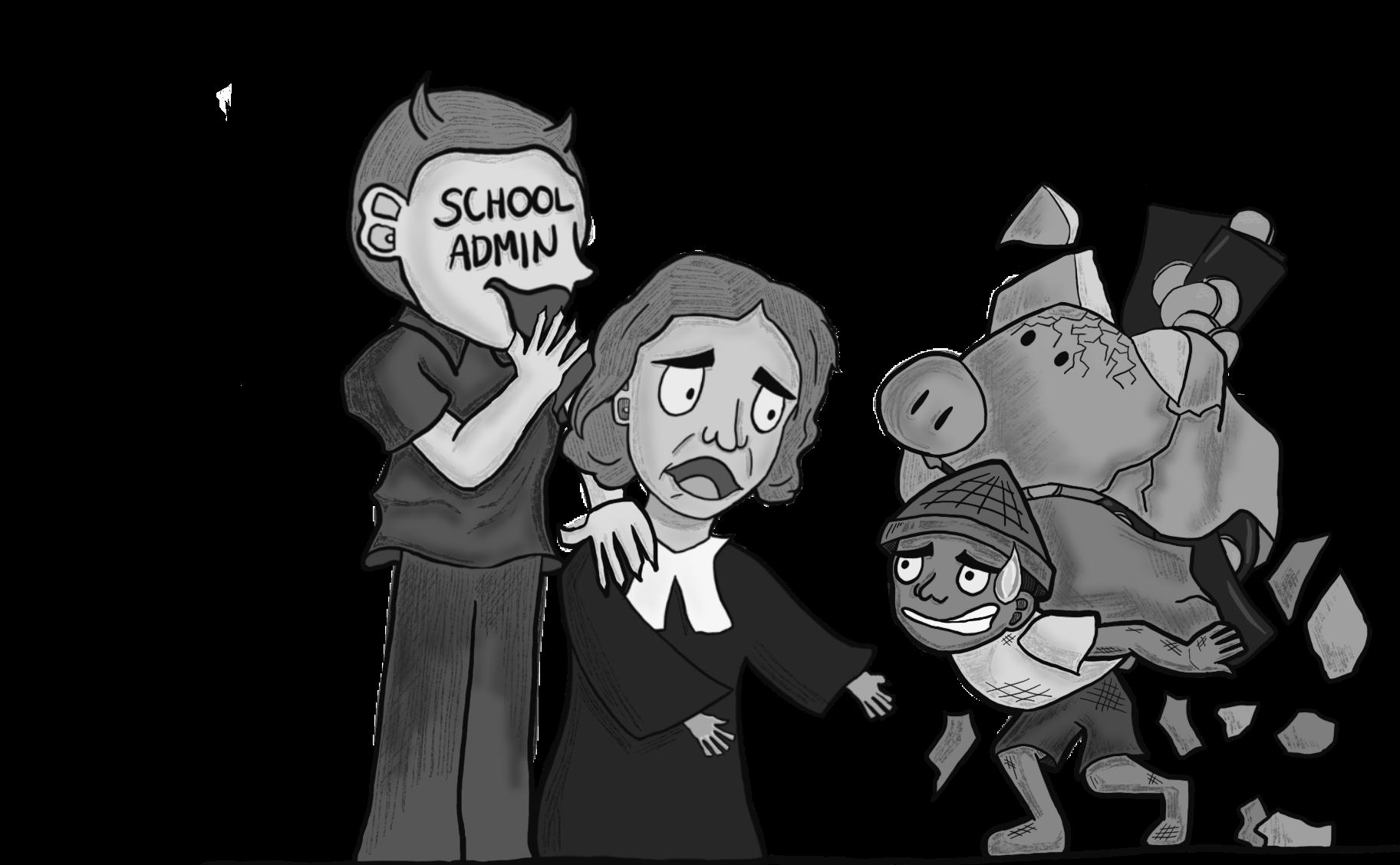

By Steffie Cheng
Against a backdrop of overpriced figurines and loud keychains, the “anik-anik girlie” has become a costume to put on and enjoy—if you can afford it.
On its own, anik-aniks are sentimental objects; a means of expression for those who hold on to small trinkets, otherwise worthless if not for their emotional value—now sold for profit by the capitalist systems of our society.
This holds true for the Internet’s newest bandwagon, as flaunted through 900-peso dolls and displayed on influencers’ designer bags. The “anik-anik girlie” trend has stripped the culture of its authenticity, transforming a once genuine passion for collecting meaningful keepsakes into a carefully curated, hollow caricature; a dull, watered-down imitation devoid of any history or emotion. This superficial trend remodels a culture driven by nostalgia into a mere fashion statement: a collectible, blind box accessory to be purchased and clipped onto belt loops or bag straps for the world to see.
This raises an unnerving question: will there ever be authentic means of self-expression immune from the grabby claws of consumerism?
This counterfeit of a practice is ever-present in private schools like De La Salle University. Well-off students brandish their charms and stuffed keychains to prop up their “anik-anik girlie” status—a title pretentiously displayed on enamel pins and 50-peso stickers sold at the university’s seasonal bazaars.
The tendency to stockpile and hoard everyday items is deeply rooted among lower-income Filipinos, often as a means
of resilience during periods of instability and scarcity. For the elite, however, these items are worthless—and, in any case, not “aesthetically pleasing” enough to stick onto their expensive MacBooks.
While capitalism helps the culture thrive and survive, the same system diminishes the wavelengths of long-gone practices for a profit-driven agenda, undermining the lived experiences of those who suffered for its existence.
‘‘To commodify, package, and sell the practices of the working class is to empower ever-powerful companies and wealthy individuals in making a mockery of a culture driven by the common folk’s history of scarcity and sentimentality.
Pre-packaged, cookie-cutter items like keychains and trinkets, while bearing a passing resemblance to the wellloved, slowly cultivated collections that inspired the trend, are ultimately soulless imitations devoid of the very nuance that the culture possesses in its rawest, most authentic form. Should we continue down this path, we risk trading meaning for merchandise.
In doing so, we watch our culture dissolve into glitter and plastic—a hollow keepsake of what it once was.
There is nothing more deafening than silence: the silence of empty seats, and leaders who never deserved to lead in the first place.
From the unclaimed HUMSS Representative position in the De La Salle University Senior High School (DLSU SHS) Student Council to the grand spectacle of national politics; when incompetence is tolerated at the highest levels, it trickles down, setting a dangerous precedent for leadership at every scale.
In DLSU alone, the vacant positions in the Student Council, coupled with the recurrence of the Abstain vote winning over any of the candidates, stands as a stark reminder that students no longer settle for mediocrity. Much like national elections, where the bar for candidacy seems to be set so low that even the most under qualified individuals can run, the student elections reflect a broader issue: a political culture that elevates figures based on loosely defined “eligibility” when it should be based on competence.
This disillusionment is not confined to the university—it reflects a broader crisis in leadership that extends to the national stage. When national elections normalize placing power in the hands of unfit leaders, it inevitably erodes the standards of governance, creating a political culture where eligibility is not synonymous to competence.
This crisis of leadership is evident in the ongoing saga of nuisance candidacies, where individuals run not to serve, but to confuse, disrupt, or gain attention. The Commission on Elections defines nuisance candidates as those lacking a legitimate campaign or clear intent to lead, yet these guidelines fail to address a much deeper issue: the persistence of unqualified figures who make it onto the ballot simply because the standards are too low. If we accept this in national politics, why should we expect better from student elections?
This trend maximizes its absurdity in Apollo Quiboloy, the self-proclaimed “Son of God” who was arrested for multiple crimes but is still permitted to run for a seat in the Senate, supported by some current senators and even the Vice President. How can a man with such a questionable reputation continue to wield political influence?
‘‘
The answer is simple: a system that refuses to demand competence and integrity will always leave the door open for the unworthy.
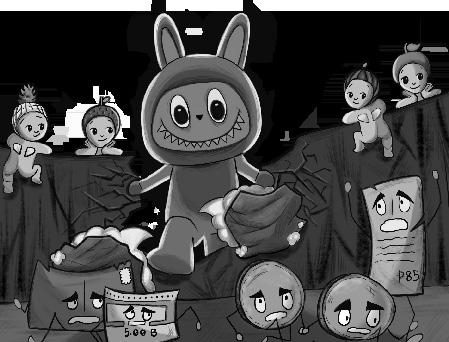
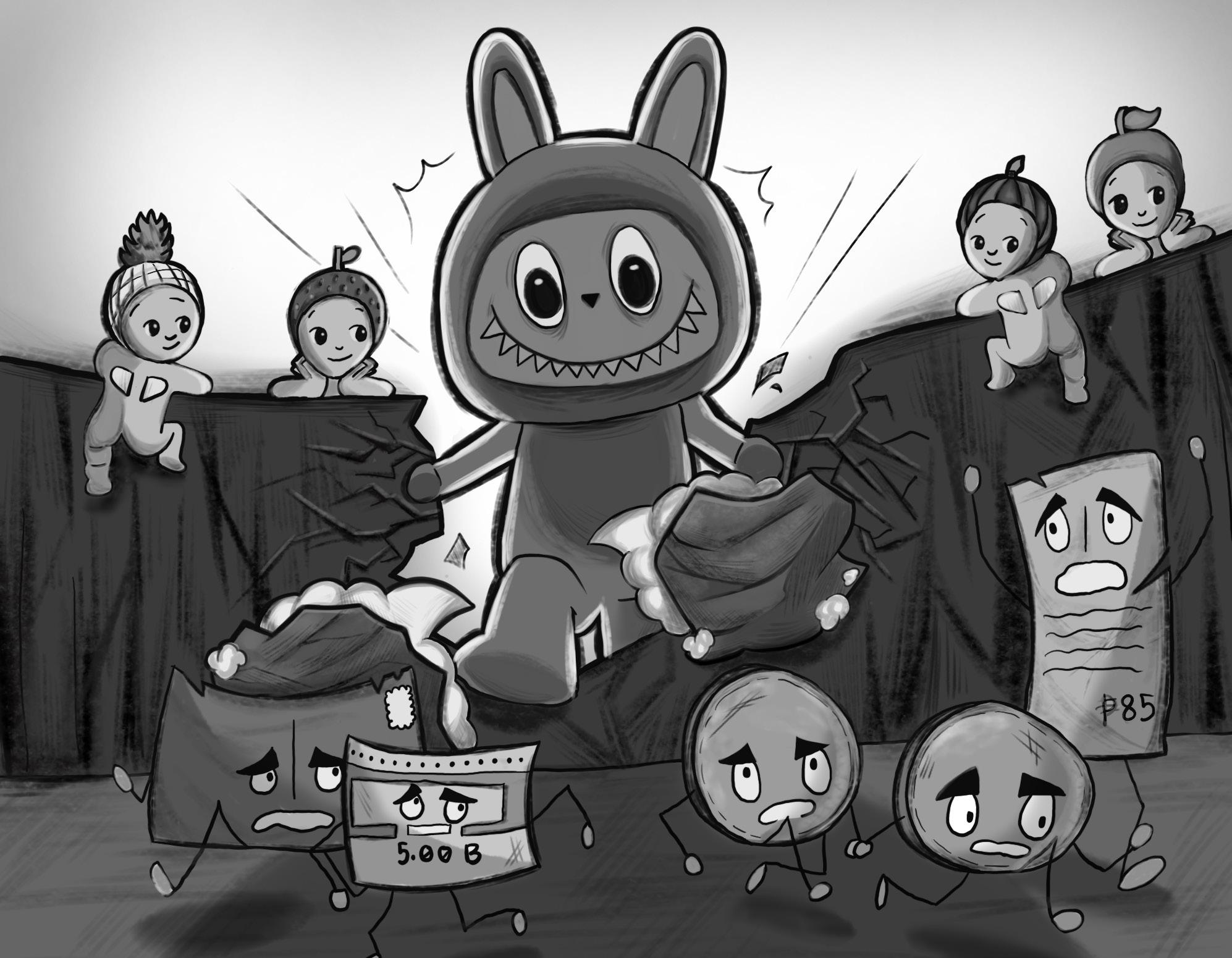
We see this lack of qualifications manifest in the very people who hold the highest offices in the land. We see Vice President Sara Duterte have a meltdown, cursing and threatening President “Bongbong” Marcos Jr. and First Lady Liza AranetaMarcos—raising serious concerns about the mental and emotional stability of those who wield executive power. Previously, she also threw a fit over her confidential funds in a budget hearing, resorting to tantrums laced with defensiveness over answering the valid questions posed to her. When the standards for national leadership are this low, it sends a clear message: positions of power can be won not through competence, but through entitlement, privilege, and brute political force.
The current standards for candidacy, whether for student government or public office, allow too many to slip through the cracks.
If we allow national politics to be dictated by unqualified leaders, student governance will inevitably follow. The absence of true statesmanship at the top has led to a vacuum of leadership in our own student councils. If the message from national elections is that anyone—regardless of merit—can run and win, then student elections will only mirror this reality.
A nation led by the unqualified is a nation doomed to fail.
By Jaedah Albano
We are those who wake up to a sharp pull in our gut. Our reckoning is persistent yet seldom acknowledged, threading through generations of women across campus in undeniable cadence. This is the collective experience of the human condition lived through—not an individual ‘burden’ to be carried.
We sit in class, reaching for a napkin in our bag, yet ending up desperately clawing through empty pockets. Even as the lecture unfolds, our call for help is perceptible only by the slightest quiver of our fingers and the brief shift of our posture. A friend leans in beside us with a knowing glance. We silently ask them, “Can you check me?” Their eyes rove over our clothes for signs of inconspicuous leakage. “You’re doing fine,” they reply. This is how we hold each other—bearing acts of support in the face of affairs kept too frequently in the shadows. In the busy hallways, we are seen once more. A professor now, we walk in a manner that’s brisk and measured even amidst the surge of pain. Today, we’ve arrived late to our schedule, with a subtle shift in our usual poised demeanor and a quiet discomfort in our movements. Having only recently started our class, there is a faint hint of discomfort in movement as we adjust ourselves in front of the board. Our period is a natural rhythm that we already know too well, yet this time, it has come unexpectedly. Still, we carry on and navigate the day with the same tenacity we constantly remind our students to embrace.
Coincidentally, we briefly end up catching the gaze of another girl in our class. Her own subtle shift in posture betrays her composure. Understanding passes between us: a jacket is offered, a reassuring nod sent, and a pat on the back gifted to create a sanctuary. It is as if we, once a student in the same halls, are now a reflection of her own struggles. We, women, are bound not just by the shared experience of leadership and learning but also by the common cycle that, though invisible to the rest of the room, shapes our every moment. The ordinary turns into something sacred—a reminder that strength is found in the simplest acts of humanity.
A few days later, a grand event unfolds. As we run around to ensure every aspect of the event is in place, for one of us, a counselor, the accolades that fill the air only deepen the scenario we carry. We work against our own body just to guide these students in their activities. As the demands of the event mount, so does the pain, all sharp and unrelenting. The cramps intensify, our focus slipping as the day’s demands collide with our need for rest. It is at this moment that we are bound by an understanding deeper than words, resilient in the face of discomfort, our strength grounded not in the absence of pain but in the defiance to continue despite it. We each carry unseen narratives bound by menstruation, making up the heartbeats that uplift this community. In the unspoken moments of our lives, our strength flows in steady waves, where resilience is forged not in comfort but in the fierce necessity of endurance. For now, our stories ripple beneath the surface, a quiet force with the ebb and flow of their bodies, constant and unyielding.
By Cara Sabillo
“To spurn masculinity is to rebel against society.”
An ideal that is taught not in words but through the subtlety of actions—the scornful glares, connotative jokes, and unspoken rejection of your identity or even sexuality. Having spent my entire life following this rule, I succumb to the hands of conformity at the expense of my soul.


By Jaedah Albano
In a world accustomed to clean, binary distinctions, the “Insert pronouns here.” tab lies in menacing silence.
Against the dim light of a laptop screen, a student sits frozen in front of their college application, the cursor blinking like a taunting pulse, waiting for them to fill in the blank. Around them, the darkness feels heavy—a quiet reflection of his struggle.
Language is the ink with which we write and define our identities, yet for many, this same jumble of letters has instead rendered them invisible, into identities lost between the lines of a rigid script. For those living outside traditional gender confines, self-expression sometimes feels like an unyielding structure, its boundaries too rigid to mirror the fluidity of existence. In this book of human expression, neopronouns are not just annotations—they are new chapters.
Will the administration poke fun at their pronoun choice? The binary simplicity of “he” and “she” no longer speaks to the depths of their experience, they found that out a long time ago. Here, within the margins, words like “xe” and “ze” emerge, bringing along a quiet yet radical potential to rewrite the narrative entirely.
When tradition defines the script, introducing neopronouns is like thrusting a new, unfamiliar genre into an established literary canon. Their parents would dare to argue its futile meaning, debating to bring up the Bible’s own conventional use of only the limited pronouns. The comfortable structure of history resists any alteration and is afraid to challenge the status quo. But this discomfort does not stem from the words themselves, as no story can remain static, and no language can stay fixed with the world it seeks to describe. The singular “they” has already found its place, and now, neopronouns—“xe,” “ze,” and “ey”—are the next logical chapters in this ongoing story.
In more and more forward-moving communities today, these questions are beginning to find more room to breathe. The student, sitting still at their desk, switches to their Canvas tab and blinks in subtle realization; there is an inquiry on pronouns. Once an uncomfortable novelty for corporate and established giants, it is now present in email signatures, in conversations among classmates and professors, and even in self-introductions on the first day of class.
But not all spaces have caught up. In a conversation with a friend, they correct a slip of their friend’s “she,” replacing it with “xe,” but the response is met with an awkward laugh, “I just can’t get used to it.” Suddenly, the weight of the moment is palpable. Ironically, in an environment that encourages respect for personal expression, the disconnect still lingers—a reminder that acceptance is not always seamless. They wonder if it’s the unfamiliarity that creates hesitation or the unwillingness to relinquish the easy grasp of “he” and “she.”
These shifts are no longer confined to the theoretical or the academic. Beyond the pages of textbooks and debates, neopronouns are finding their way into everyday conversations. They are not complications but revelations, reframing our understanding of identity through each utterance. These words are less about rewriting the rules and more about adding depth and nuance. A reminder that language has always been a living thing—constantly evolving, as fluid as the identities it attempts to describe.
Neopronouns are a work in progress, a crucial chapter in the ongoing narrative of human expression. In allowing these words to breathe, the student releases a heavy sigh. Not only has the way of speaking changed but the way of seeing one another has also been transformed, creating space for all lives once invisible, now revealed in their full, unapologetic truth.
However, the world never ceases to constantly remind me that I do not belong. At the dining table, my father stares me down with a questionable look as he sees the cross of my legs. “Babae ka ba?” he jests. Hurriedly, I sit upright, staring at my food and pursing my lips—an effort not to let the tears slip. It gets harder to hide my identity under nitpicking eyes. Perhaps, to live in homosexuality as an Iglesia ni Cristo member is a curse; the struggle to choose between myself or God haunting me in my smallest acts of expression.
The search for my place in this world carries on, yet each day only seems to end up in vain. At school, I feel a million eyes glaring knives behind my back, their verdicts questioning my gentle mannerisms and feminine demeanor. I find myself avoiding restrooms, lockers, and closed spaces—afraid I’d get ridiculed by my peers again, their actions scarring both my mind and my body. Was conforming truly the only way to survive? I couldn’t find anyone to turn to; my family, friends, and even the church made me feel unwanted and disgusted with my being.
Yet, despite their notions, I never saw my sexuality as one that degrades me. To have freedom in choosing whom I love and what I do did not make me a prodigal son or a horrible friend. My heart knew that even God wouldn’t outcast me for loving another as much as He loves me. In the quiet corners of my room, I found a place of solace. Every night, I would watch the blue haze of the television as it showed me a beauty I’ve always sought to behold. “They’re just like me,” I thought as each of them strutted down the runway cloaked in dazzling jewels and colorful makeup. I was captivated by them, for these drag queens were the very personification of art itself. At that moment, I felt hope. Perhaps, there was someplace out there with a home for those like us.
Slowly but subtly, I immersed myself in the art. I adorned my neck and wrists with silvers of jewelry as I tinted my lips with flecks of color. Although I was still met with repelling looks and mocking comments, I felt freedom in simply expressing myself in this fashion. My parents may have seen me as a rebel, and my friends now call me different, but I know deep down that none of it was true.
In liberation, I did not stray far from home; instead, I finally nestled within its I met others within my religion who were of the same kind, our stories still somewhat closeted out of fear and rejection. Yet, despite this, our vibrancy will not dull. To live life through every shade of the spectrum is to take pride in yourself entirely, loving each part from the unconventional to the extraordinary. With our tales winding together, I know that one day, they would fully bask in the light—the world would soon see that our beauty is a perfect gift in its own radiance. In the end, perfection never lies in perceiving eyes; it is always within the confines of my heart.
In the art of drag, I am free. The hues of my soul may be different from theirs, but deep within my heart, I am a beautiful masterpiece.




By Cara Sabillo
They say that a cat will remember you for nine lives, so in each of them, there will always be people who love them back tenfold.

It was a post-Christmas day, and while Manila basked in sunlight and festivities, a small cat wandered the streets near De La Salle University (DLSU). He had no name then—only bearing a soft orange coat and a habit of curling up wherever warmth welcomed him. Some say he once slept in the Christmas belen at St. Scholastica’s Church before he vanished. Others recall seeing him weaving through the campus gates, his tail flicking
However, his stroll seemed to stop as though the world did alike. A clashing engine screech billowed in the air due to a motorbike’s brakes struggling to catch in time. Tires skidded across the pavement. Then, the impact came. The frail kitten lay motionless, his once orange-striped fur now dyed in hues of crimson. His right eye seemed beyond saving. His jaw was shattered. Half of his lungs had collapsed. Had no one intervened, he would have been left there—a forgotten casualty of the city’s indifference.
But fate had other plans.
A campus guard scooped him up while another ran off to find help. They knew exactly who to call—DLSU PUSA, the organization devoted to ensuring the welfare of every campus cat, come rain or shine. Within hours, he was rushed to a veterinary clinic, wherein X-rays confirmed the extent of his injuries. He needed an enucleation to remove his destroyed eye, reconstruction for this broken jaw, constant oxygen support, and a feeding tube to keep him alive. The cost was staggering, but for the volunteers, there was no question. They
He was named Ubermeow, after Nietzsche’s concept of Übermensch, meaning “Superman.”
Members sat with him through the long nights and collaborated to fund the surgery despite its overwhelming costs. Nevertheless, their sacrifices were not theirs alone. Their plea for help in sharing Ubermeow’s story online touched many hearts, with fellow Lasallians later offering a hand in saving a beloved campus friend. Far beyond the confines of a mere extracurricular, this was their service—to protect the beings we coexist with, no matter the compromise.
Now, it has been a month since the accident. Just like a true superman, Ubermeow is still fighting. He is completely blind now, yet his spirit has remained unbroken. His tale is only a part of the immense archive of love that DLSU PUSA has built. Their warmth extends infinitely, encompassing adopting cats, rehoming them, feeding them with no fail, and even documenting their lives for the whole community to adore. Their work is a testament to their fervent desire to provide these animals a life that is lived as beautifully as our own.
After all, these creatures chose us. Their existence is a symbol of a human’s kind heartedness and empathy to provide them with a haven of peace and comfort. It is said that love and compassion are the necessities of life, and perhaps, it is




The year was winding down. Still, it seemed that some things never really changed.
The December air was just as biting. Students remained to traipse in histrionics about the last few dregs of exams, and Lito would stand near the sports building with his ice cream cart all the same. Like everyone else who had been anticipating the term’s end, he would be closing the shop early today, eager to join his daughter’s invitation to watch the basketball game in Rizal Stadium. But before the game, there was just one last thing to do: a shared respite with an old Michael arrived as he always did—rugged yet strangely endearing. A campus security guard in his late 30s, he had his hair sprinkled with bits of gray at the temples. His uniform hung loosely around his tall frame, crinkled from the long shift. His demeanor to most was typically unassuming; however, once his raucous laugh erupted, it was enough to light up anybody lucky to hear it. Such was the case as his lips split into a crescent upon spotting his friend’s food cart.
“Nandito ka na,” Lito said with a knowing smile.
“Siyempre, ‘di ako pwedeng makaalis nang hindi dumadalaw,” Michael replied.
This December, Michael would finally be flying home to his family in Visayas for Christmas. It had been three years since he last spent the holidays with them, so a curious amalgamation of sentiments fluttering in his gaze was one to be noticed. He worried whether or not his kids—now six and 10—would remember him the same way. He ached and craved—as though the plane ticket in his bag could momentarily lift the weight of his responsibilities off of his shoulders.
His friend scooped up a generous serving of ubeflavored ice cream, already knowing that it was his usual order. It was a serendipitous thing to be tied in the crevices of Manila together for years: the familiar man outside the green gates, the familiar stand where
colleagues sometimes stopped for a snack, and the fiery first conversation sparked by complaints on price hikes. Now, as they shared the treat under the waning sunset, they meandered through familiar territories: debates on basketball strategies, their families, and the sacrifices they made for the people they loved.
Lito was a vendor who had spent hours on the busy streets of Manila. Every early morning and every long day of selling were to support his daughter, a firecracker of energy. After he lost his job as a shipman during the pandemic, life had never been easy for them. There was always the pressure to make ends meet and the fear that it might never be enough in the end. Still, he had seen enough hardship to understand the value of steadily pushing forward.
Michael, too, understood sacrifice. His heart ached at leaving his wife and two children behind, but he knew it was necessary for their future. Loneliness was his constant companion, creeping in during long, quiet evenings. Thus, the friendship was a source of comfort for both, and hearing his good news made Lito’s heart swell with happiness.
“They’ll be so excited to see you,” Lito said, picturing his family’s wide-eyed joy once he walked through their door.
Later, as Lito closed up his shop and met his daughter in the stadium, his thoughts lingered on his and Michael’s conversation. Life, he realized, was much like basketball—a game full of challenges, setbacks, brilliance, and mistakes. Yet, above all, it’s about working and laughing together. Soon, the two men would return to their own posts, greeting students with the same easy grin. Some might walk past without a second thought, but Lito knew better.
In the grand scheme of things, it is the quiet kindness of these people who keep the world running—the ones who stand, watch, and show up every day. And for all that, he feels deeply thankful.


the room—a meek signal of his affection and love. He was rather fond of mischievous stories and of laughing over silly mistakes and accidents. As a child of nine siblings, he had been used to chaos in his household, too apparent to be missed. A wide smile was aboded by the simple amusement of TikTok trends, cross stitching, and his most beloved topic of all, chemistry, of which he was a cherished professor in Minnesota and the Philippines. Looming into his hobbies, there can be no dismissal of his crossstitch exhibit, where he showcased his notorious stitch piece of the periodic table after two decades of stitching. Pauline had helped with its opening, beaming with pride as she saw him in awe over his very own masterpieces on display.
But it was 40 years ago in Manila that he stepped foot alone all the way from the United States in 1985. Despite supposedly retiring in 2000, he returned in 2013 to continue in service, during which he met Pauline. He found a home amongst the people he had loved despite never seeming to understand the local language. A sacred invitation from Br. Andrew Gonzalez, an old classmate and friend, started the narrative. It was the hot weather that drew him in, boasting constantly of how it was just right despite coming from a relatively cold state.

By Cara Sabillo
It is said that a cup of coffee is a cup of hope—a boost of serotonin even for the most tiresome of days. But for some, it truly is the epitome of hope— another reason to watch the sunshine rise another day.
The earthy smell of coffee beans emulates a warm-lit kiosk, its baristas relishing in tender comfort at the first crack of sunlight. Silingan Coffee, situated at the grounds of Yuchengco Hall, is where stories wind together—a place where newfound bonds are shared over the aroma of cinnamon and espresso.
For Nanay Lourdes, the shop was a space of comfort; it was a refuge for souls who wished to heal and recover from the grief of a love long lost.
Founded in the memory of those lost to injustice, Silingan began brewing to help families with members who had yielded to the cold, gruesome extrajudicial killings. It was within the walls of the coffee shop that people like Nanay Lourdes found a light to bind them to the world once more. To lose a loved one to political oppression is to experience grief that never really disappears. This pain is one that the baristas knew all too well—the sullen absence of warmth within a home that only grew harder to endure each day.
The killings took countless innocent lives, closing innumerable stories with unfinished chapters. Yet, this is precisely why those who carry on the grief continue to fight. With the loss of her husband, Nanay Lourdes’ life gained a deeper purpose: to protect her children and their futures—once a dream shared by two but now one she must meet alone. She stands as a beacon to seven of her children, making coffee to fulfill their dreams. To her, this is the greatest act of love she can provide to her late spouse, a brighter fate for the little ones who have lost half of their home too soon.
While the heartache never truly leaves, one learns to live with the sorrow and continue rising with the daylight. Nanay Lourdes, surrounded by those who share the same fate as hers, has found a home built upon shared anguish yet backed by a stronger resilience to overcome it. Slowly, her mornings felt lighter, the burden of life mellowing upon her shoulders as she looked forward to every day’s kwentuhan woven with memories of nostalgia, tears, and laughter. Although the presence of those from the past was no longer physically there, their souls were undoubtedly alive, pulsing with joy in the hearts of those who remember.
In its years of service, Silingan has stayed the same, but somehow, it feels brighter, happier, and more blissful than ever. The coffee shop has long extended its help to countless victims, aiding them financially and providing their bereaved families with their daily needs. The ray of hope Nanay Lourdes found and clung to has opened its doors to all those who endured the same pain, hoping to find refuge just as she did. With each coffee she brews, she shares her tale with students who stop to listen, enlightening them on the cruelty of the world and, more importantly, one’s strength to rise above it. Her story is cradled by the hearts of many, inspiring others to search for their source of hope amidst adversity.
The warmth of a coffee may never compare to the affection of a loved one, but it is in its tenderness that we honor their souls. In love and remembrance, the baristas continue their service, immortalizing the sentiments of those they’ve lost and the tales of many others in their craft. Perhaps there truly is a subtle serenity found in the act of brewing. As they live and fight for justice for the departed, their life will be known as one of bravery and resilience—a beautiful narrative that the rest of the world may one day behold.
He was still speaking that morning of January 11th, a day before his passing. But it took less than 24 hours for everything to change. A message was sent on how his health was deteriorating—as it had been for the last two years. The pain of saying goodbye settled in until the next early morning at one, with Pauline staying beside her best friend; still, it was not without the preparations born from love and care, seeping close around the same faith, service, and mission he had dedicated his life to. She had been there with him, paralleling, even when she had been diagnosed with pneumonia, he had stayed in the hospital for much longer to remain with her despite loathing it. It is not easy to wrap hundreds of words into a single life. There remained piles of paragraphs and narratives left unsung. But forever etched in his memory was a key kindness amidst the tremors of negativity. For now, in another’s closing chapter, they— we—must grieve. It is in these moments of shared burden that memory flourishes and lives anew amongst eternity and anguish.





it means to stand before the barrel of a gun, but you understand what it feels like to vanish—to be lost and to feel unseen—don’t you?
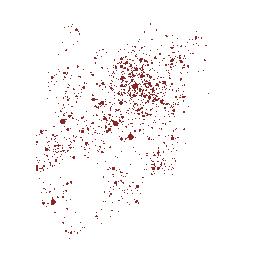
I’ve watched her small body curl up in the corner of the room, as though by hiding, she could make herself invisible. There, in the quiet shadows, she asks herself what it means to be seen. At such an ingenuous age, how come she is already aware of her place in a society where knowledge is power and power is reserved only for the ones who wield it? At her young age, she is already learning something that many grown-ups have forgotten. The frail body of a kid running around under the sun understands perhaps more than they ever will that in this world, her voice is often drowned out by the voices of those who make the rules—the ones who write the laws. Now, she sits on my lap quietly, asking me all the questions they choose not to answer.
A bill sits within Congress, its ink still fresh, proposing the death sentence for robbers hungry for corruption—a promise to balance the scales of justice. House of Representatives Speaker Martin Romualdez told the media that the law would punish the greedy. Yet, the cries of the innocent linger in my mind as my daughter looks up at me, her ears untainted by their cries of truth that no one will hear: “I didn’t do it.” But the sentence has already been sealed, and the punishment decreed. It is too late for the truth, and I wonder if the slight pull at my lips is enough to keep her curiosity satiated.
She may not fully grasp the gravity of corruption or conviction, but she knows that when those in power call for justice, it is often meted out with a scythe. Combing through her hair, I realize she has yet to know how a bill becomes a sentence or how ink on paper can turn into gunfire at dawn, but she has felt it before: when I leave without saying goodbye or when a friend’s laughter fades into the distance as she goes home from school. The hollow space left behind is all too familiar, and in the quiet of her tender thoughts, she asks me, “Ma, if the grownups decide that a bullet becomes someone’s last word, can someone who has done bad ever be good again?”
She is not hardened yet, not like so many others who have lived longer and become jaded and tired. But there is a quiet understanding that stirs in her—an awareness of the ways in which power shapes the truth.
“It’s not fair,” she whispers into my ear, her voice a breath of wind against the weight of these decisions. “No matter what, someone is going to get hurt.”
Her gaze shifts upward, mind drawn to the distant heights where decisions are made, far removed from our world below. To the riverside palace where those in power sit, grown-ups speak in booming words as if the sheer force of their speech can alter the very course of fate. The government insists that executions will send a message––that fear will repress corruption or that a lesson will be taught. But, history speaks louder than any law, and it whispers a truth no one wants to hear. My child, a blurred reflection of my ten-year-old self, may not yet have the words for it, but her small hands already know the answer.
All the stories I’ve told her bear the heavy weight of promises unfulfilled by the people who sit in power. Stories of the drug war—of the many who died in the streets without trial, of children like herself, who wonder why some people are killed for their mistakes, where families weep for their loved ones, their names forgotten, their lives erased. Stories where the innocents fell alongside the guilty and justice remained elusive like a shadow that never quite reached its form. Yet, the bill surges forward, driven by a hunger for retribution and a desire to erase the wrongs with a stroke of finality.
As a mother, it consequently becomes my duty to protect her heart, still untouched by the cynicism of a world bent by power—remaining quiet. Her thoughts have yet to form fully, but they are there, swirling like a storm over the horizon. What does it say about a nation when its children, with hearts untainted and questions still unanswered, have already learned to bow?

On their ninth wedding anniversary, Marc and Mila received a different kind of flower: Typhoon Trami, named after the enduring trami or camellia bloom. From 236 miles away, Marc watched helplessly as Trami—locally known as Kristine—pummeled his hometown, Naga City. Two years of working as a company driver in Manila had separated him from his wife, Mila, and their four children. “Dito po ako, para makapag-aral mga anak ko…” Marc said, his voice thick with a mix of longing and determination. Their wedding anniversary had passed just two days ago, a bittersweet reminder of the life they were building apart.
On Tuesday, Trami made landfall. Mila had just finished her shift at the bodega when the winds picked up. “Akala ko normal na ulan lang. Pero biglang lumakas, ang bilis,” she said. At home, she gathered the children in the back room, away from the windows. The twins clung to her, silent with fear. “Sabi ng panganay ko, ‘Mama, lalakas pa ba?’ Hindi ko alam ang isasagot ko.”
Marc sat in front of the TV in Manila, heart pounding as news reports showed flooded streets and collapsed houses in Naga. He called Mila, but the line was choppy. When it finally connected, her voice was strained. “Hindi nakapaghanda ang Naga. Sobrang alanganin ng sitwasyon.”
Marc wanted nothing more than to be there, wishing to trade the sterile walls of the city for the fury of the storm in Naga. But he was a prisoner of distance, his screen the only window into the destruction: the flooded streets, the toppled posts, the muddy water.



By
The fluorescent lights of the examination room hummed, casting a sterile glow on his face. Another MRI. Another battery of tests. He went about his day as a high school student punctuated by invisible tremors, the insidious crawl of migraines, and the ever-present suspicion that he was making it all up.
“Psychosocial,” the doctor had said, the word hanging like a knife over their heads. “This means it’s in your thoughts and emotions.” “But it’s real,” he wanted to scream.
The world, with its jarring noises and overwhelming stimuli, often felt like a ship tossing him about in a tempestuous sea. Dissociation would settle in like an unfamiliar weight, dragging him into a hollow space where time and place felt elastic. The pain, a relentless hammer against his temples, would render the world a mix of throbbing noise.
Yet, to the casual observer, he appeared hale—walking, talking, functioning. “You’re just being dramatic,” they would chide. All shunned his burdens—from a teacher when he asked to dim the lights, a classmate when he excused himself during a school event, to even his own relatives when a migraine struck during his cousin’s 18th birthday party.
On the day that he finally began receiving professional treatment for his migraines, he got his Persons with Disabilities (PWD) ID. “Look! Here is proof that I was not making it up.” But the relief was short-lived. Relatives, once dismissive, now clamored for the discounts that came with the ID, their eyes gleaming with a predatory glint. The joy of newfound support was quickly overshadowed by a bitter taste of instrumentalization. The daily battle inside his brain was now another conduit for financial gain.
There were now eight million PWD IDs in circulation: a number so bloated it turned the real ones into question
By Patricia Yu
Barangay officials arrived at Mila’s home to distribute relief goods—bath soaps, simple clothes, and canned food. Yet, these meager provisions barely offered her any comfort, “Kulang na kulang.” Marc’s phone rang from the other end, and a video call from Mila cut through his thoughts. He saw her despair, the fear in her dark eyes behind the weight of four children on her back. He felt eaten alive by guilt, a gnawing sense that his absence had somehow contributed to her suffering. He was the breadwinner, the protector, and yet there he was, thousands of miles away.
Marc sent extra money home that week, but he knew it wasn’t enough. Worse, this was just the beginning. The news warned of six more typhoons predicted to hit the country in the coming weeks.
“Paano kung mas malakas pa ‘yung susunod?” Mila asked. Marc had no answer.
Marc and Mila, like the trami with its deep roots, must endure. Whispered promises on staticky late-night calls were their lifeline to a future together. Their resilience stood evident in Mila’s stretched pesos, Marc’s double shifts, their joy in small things, and their determination to rebuild after each storm.
Their love, a force of nature in itself, must hold on through anniversaries amidst the storms—a resilience born not out of choice but by necessity. But their love is not the only thing that endures—so do their struggles: the creaking walls, the years of distance, and the constant threat of the next disaster. And while Trami endures, it should not always have to.

marks. The government had announced it would go after frauds exploiting disabilities for financial perks, but beneath the hunt for impostors were people like him—forced, once again, to prove their pain.
And so, skepticism hung in the air like the thick Manila smog. “Fake IDs,” a fellow passenger hissed. With the recent crackdown on verifying the authenticity of PWD IDs, his pain was not only ignored but scrutinized, as if he were just another impostor.
They asked, “Paano ko malalaman na totoo ‘yang ID na ‘yan?” He could not explain the frustration of living in a world that demanded proof of disability when every day was a struggle without any visible mark to show for it. How could he articulate the isolation of being told to demonstrate a wound that only existed in his mind? The absurdity weighed on him—as attention-grabbing as PWD IDs had now become, society still failed to address the everyday obstacles that couldn’t be encapsulated on a piece of paper. The ID had become a symbol of validation, but it did nothing to confront the very real, often-unseen barriers that shaped his life.
“Prove it,” the world demanded. Prove that the little ID in his wallet was not a scheme, that his pain was not a fake, and that his suffering was not an economic inconvenience—as if the very existence of counterfeit struggles erased his own reality.
His PWD ID had once been his proof, the one thing that made the invisible visible. But now, even that was in question. If a card wasn’t enough to make them believe, then what was?
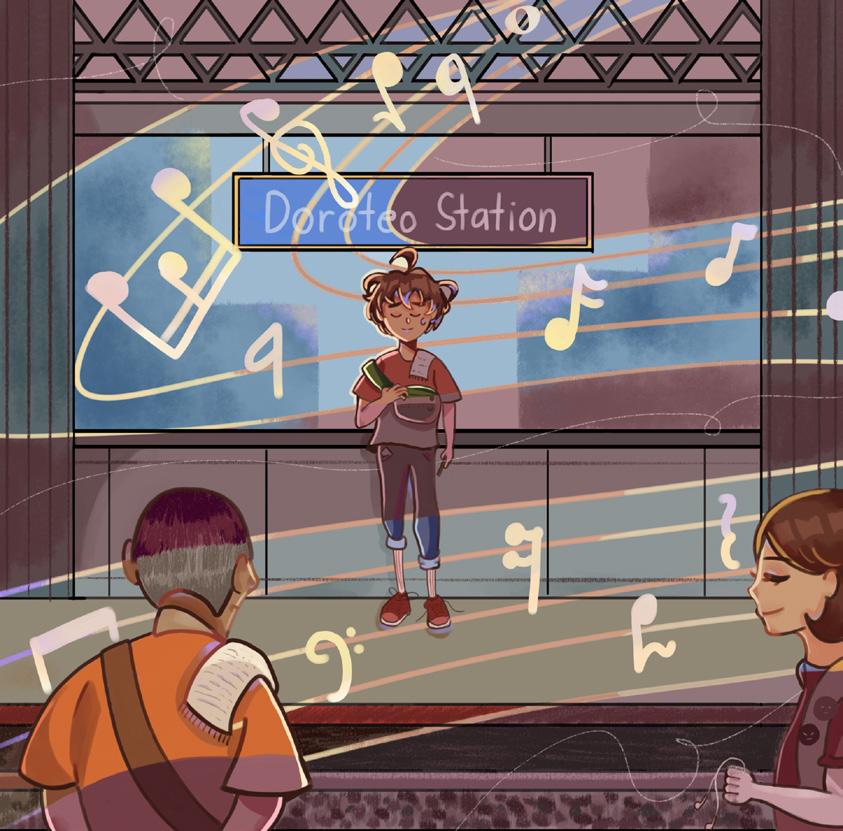

By Elijah Margimen

Fluorescent lights from distant buildings reflect off the passing trains as they weave through the monotony of Light Rail Transit station Doroteo
Here, the fatigued faces of commuters leave and enter the train’s metallic jaw, the neon glimmer of billboards shining on our eyes further amplifying our turmoil. Caught in the heart of Metro Manila, we blur into an array of colors and movements.
Among those rushing, I mask my exhaustion with a stoic face; my shirt is creased as the bag pressed against it barely hangs from my shoulder. This is the rhythm of my daily life, an unchanging cadence of hardship and resilience. Yet, to my side, a group of men suddenly put down a heavy black guitar case and erected a tall steel music stand. They go unnoticed, cloaked by the sounds of chatter and heavy footsteps. I, hoping for a moment of respite, make my way toward the station platform while a subtle shift ripples through those around me.
Just as the horn of the approaching train makes its way in, the noise of monotony breaks with the melody of guitars strummed, the rhythmic thump of cajóns, and the jingling of tambourines. I turned around for the first time to see buskers playing their instruments amongst the stalls whilst a gentle voice accompanied them. Students ended up giggling as they recognized one of the love songs, a police officer swayed to the rhythm of the beat, and I stopped thinking about work to simply admire the

This is a festival of reborn art.
The Metro Manila Film Festival (MMFF) parade, a riot of color and music, has always held a promise: Filipino stories will live on, shared from screen to soul. In its 50th rendition, the MMFF vowed a renewed vigor for Philippine cinema, but the reality was far from the celebratory promises it once held. Beyond the glittering floats and technicolor confetti lies an industry in grayscale, struggling to breathe against the suffocating weight of Hollywood blockbusters and shifting audience preferences.
Despite the festival’s glittering pageantry, its box office statistics cast long shadows of doubt. Of the 57 films submitted, only three managed to break even: And The Breadwinner Is…, Green Bones, and The Kingdom. These entries were each a prism reflecting Filipino life in raw and unvarnished hues, whether personal, artistic, or cultural. Green Bones and The Kingdom tapped into the psyche and struggles of a nation haunted by its own past, their storytelling capturing the very essence of collective fears. Meanwhile, musical productions such as Muling Umawit Ang Puso stood as an ode to the golden days of Original Pilipino Music, a nostalgic reminder of an industry fighting to be heard. Though the numbers revealed a grim reality of oncecrowded cinemas with seats like gravestones marking their viewers’ deaths, the brilliance of the festival refuses to be dimmed.
At the heart of this struggle lies a disconnect. In the corridors of cinema halls, the towering posters of Hollywood blockbusters command attention, while Filipino films merely fight for a sliver of space. Filipino audiences, revealed by the Film Development Council of the Philippines (FDCP), are turning away from local films.
Fewer people are watching movies in theaters, with most opting for streaming. FDCP Chairman Jose Javier Reyes laments, “The mystique of the silver screen has faded.” Social media’s endless parade of curated personas has dulled the charm of traditional storytelling, giving way for independent digital creators to transform the modern landscape of visual storytelling. But even as the films struggle to fill theaters, there’s something beautiful about their effort to keep shining. The MMFF, in all its spectacle, is not just a celebration but a plea, a final burst of brilliance demanding to be seen before the industry either reignites or is reduced to a flickering memory.
Reaching its pinnacle, applause rang out on the night of the awarding, but whether it was for cinema or these familiar figures standing at its center was unclear. In a scene captured by cameras, Senator Robin Padilla was seen sharing a lighthearted exchange with the cast of The Kingdom, while Manila Mayor Honey Lacuna stood under the same gilded light as the night’s true honorees. The audience’s gaze shifted—politics had slipped into the scene like an uninvited guest, the reverence of cinematic triumph growing heavy with the undertones of an unspoken subplot.
Yet, amidst the vibrancy of the events of this film season, one cannot help but wonder if this is the moment Filipino cinema must begin its reinvention. Filipino cinema, at its best, has always been about resilience. Thus, the reels continue to spin, their rhythms steady and their promises eternal. As the Film Festival’s colors fade into the horizon, we are left with one truth in search of clarity: These stories will survive. In the shadows of the stage, it waits—ready to rise once more, soon with a brilliance that will outshine the fleeting moments of today.
The cursor blinks on the empty file, its unrelenting flash mocking the stillness of his room.
He exhales, staring at the vacant document as if sheer willpower could summon ideas onto the screen. His laptop hums in the silence of his dorm, the glow of the screen casting sharp shadows on his desk. Outside, Manila thrums, echoing distant car horns and occasional bursts of laughter from students who can still afford to call it a night. But in his room, all is quiet— save for the constant buzz of his laptop and the air thick with the scent of coffee, cold and untouched.
music. Then, before I knew it, the train had arrived. I rushed to enter as the doors were closing, the music fading along with it. Yet, as the train entrance shut, the melody still lingered in my mind.
Day by day, the cycle repeats as commuters come and go; some pause and leave a tip, while most merely pass. Regardless, just like the stations’ operation, they press on. The train continues to rattle on its tracks while the buskers’ instruments strum against the same weariness, offering a melody of resilience to those passing.
Though they may pass off as second thoughts to most passengers, the buskers will continue to set up on the same corner, playing songs to ears that may not listen. Together, we refuse to give in, finding meaning in our routines.
Hours pass after I finish my work shift, and I’m finally back at the station—tired but not broken. I get there to find the busker continuing his music for those passing, his guitar case open to only a handful of coins and a few crumpled bills, barely enough to make a living. The long hours they play yield little, yet they continue to perform through the crowd’s indifference. This time, I thoroughly savor the sweetness of his lyricism. I look around to see others pass by, equally tired but with faces adorned in joy. Their music proves that even in the hardest of times, there is always a melody worth sharing.

By Jaedah Albano

His to-do list is an impossible equation. The deadline for a commissioned project that could open doors awaits his impetus. But his phone lights up with a grim reality: three major papers, a midterm exam, and a group project where he, as usual, carries the most weight. He runs a hand down his face, the exhaustion settling deep, somewhere between his ribs, wedged in the space where passion once lived. The rush of getting paid for something he loved, the thrill of seeing his work shared by strangers on the Internet. In ninth grade, commissions were just that—a side hustle, a proof of skill, a bonus. Now, they are late nights and the gnaw of obligation—the quiet dread of knowing that when your art becomes your income, the lines between joy and duty begin to blur.
The minutes collapse into hours. His world narrows to keyframes and color grading and to the mechanical rhythm of his keyboard. Messages pile up. His group mates reminded him that their research paper was due in five hours. His stomach twists— not with hunger but with the weight of everything unfinished. By the time the sky stains itself with the first light of dawn, he remains slumped at his desk. The city wakes as he runs on borrowed time.
By Jaedah Albano

There was a time when student commissions were a spark—a creative outlet that was both an escape and a challenge. It was about proving his skill, seeing his art shared by strangers, and feeling that rush of validation. But in a country where part-time student jobs remain underdeveloped and scarce, this outlet has become his full-time job, and what was once a hobby has now become an obligation, and that spark is now buried beneath deadliness and quotas.
But in this struggle, there is beauty too.
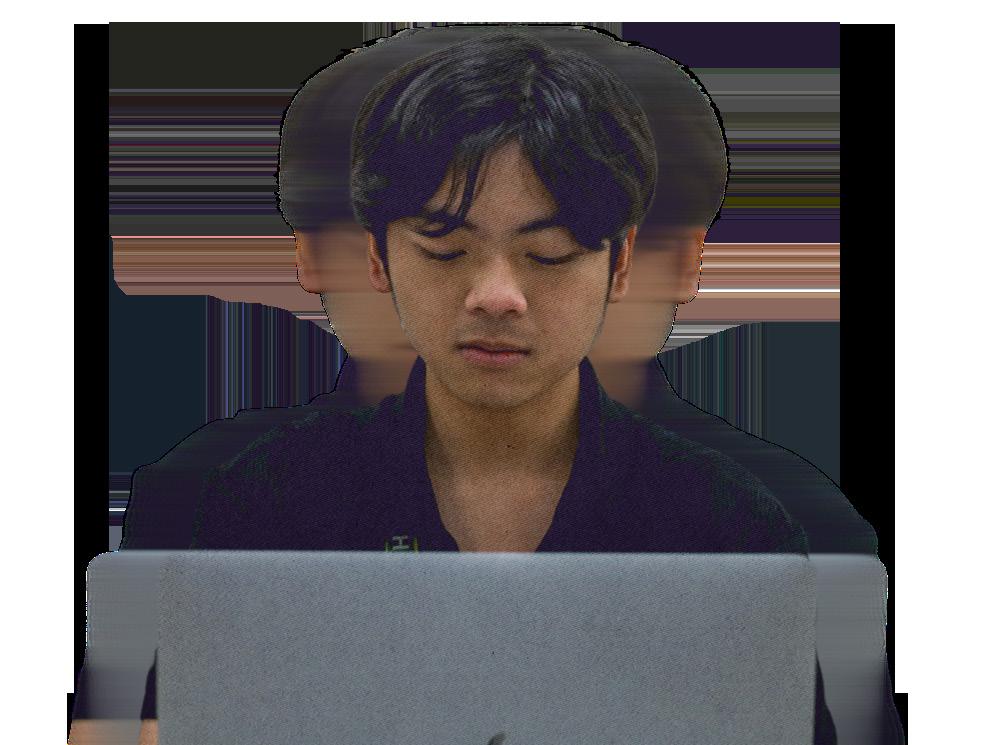
In a system where students are left to fend for themselves, where there’s no safety net or support system for those juggling school and labor, this community is built not only from necessity but also from ingenuity and a shared love for creation. A sense of belonging etches itself into his heart the way a single project can light up his disposition with excitement. The community of young creators who share their work, their struggles, and their victories— it’s more than just a network. Students come together, building a place for themselves, learning to balance and carve out their space in a world that offers no easy solutions. These moments keep him going, reminding him why he started in the first place: to create, to learn, and to belong.
In the end, it’s about finding balance. It’s about carving out time for oneself amidst the chaos—to create without losing what makes the work special. But even as fatigue lingers in his bones, his fingers hover over the keyboard, searching—for balance, for a way to create without losing himself in the process, for a version of this work that still belongs to him.
By Gabrielle Micha Co
Robotics, a seemingly intimidating field reserved for only the boldest and the brightest, holds undeniable power over modern life. Though seemingly daunting at first, this field welcomes anyone willing to try. In its plight to train its students to thrive in the current technological landscape, De La Salle University-Senior High School (DLSU-SHS) does just that, openly heeding this call to integrate this field into its education.
DLSU-SHS remains steadfast in its mission to equip students to be more technologically capable with subjects like Empowerment Technologies, which helps students learn basic programming with Python and simple data visualization. Through these courses, students are able to integrate simple coding language in day-to-day functions like an Automatic Transaction Machine (ATM) system. However, no part of the curriculum is specifically dedicated to robotics.
Even so, robotics education at DLSU-SHS is ever present in its extracurricular activities through its organizations. Many students have also taken the initiative to join robotics competitions both locally and internationally. Recently, students bagged awards in the World Educational Robot (WER) Competition World Championship held in China last December, with two teams bagging awards in the Brick 4+3 Category in the High School Division.
Particularly, DLSU-SHS’s own Engineering and Robotics Club (ERC) caters to Senior High School students interested in all things tech, honing their skills in topics like Arduino, computer programming, and more.
“We’re trying to foster a community where people can try out what they want when it comes to mechanical engineering and stuff like that,” shared Cedric Tan, ERC’s Executive Secretary and one of the

team members who had bagged the WER champion award. “We want to make it easier for people to compete in (robotics) competitions.”
Tan explains the need for specialized classes in robotics. Although there have been classes somewhat adjacent to robotics, such as Empowerment Technologies, these only encompass the computer programming aspect of robotics and still do not consider the hardware component of robotics.
“They might not realize that they’ve already been doing some sort of mechanical engineering already, since playing with Lego bricks or putting stuff together to fix something is already a good start to fostering a mentality for engineering and robotics,” said Tan.
He emphasizes that though robotics may seem scary and intimidating, it usually just takes a leap of faith to try something new. With engineering and robotics’ forgiving nature, sometimes all it takes is a bit of time and effort.
As we progress further into the digital age, it is almost a necessity for people to be equipped with skills calibrated to the needs of our current technologydependent society. Now, robots can stray further from the concept of humanoids taking over the world and closer to figments of our present reality, turning the vision of our automated dreams into a world of our own design.


By Martina Javier
Beneath our feet lies a world teeming with untapped knowledge waiting to be heard. The 2024 National Winner of the James Dyson Award and Lasallian graduate, Joseph Aristotle de Leon, embarked on a journey to uncover this information and spark a revolution in environmental monitoring with his cuttingedge invention, the Resistivity Acquisition and Monitoring of the Underground (RAMUN).
RAMUN’s system detects pollutants leaking from landfills and storage tanks into groundwater by generating real-time videos of underground conditions, allowing us to "see" beneath the surface.
This system has two major components: transmitters that send electrical currents into the ground and receivers that detect electrical signals reflected from underground. When RAMUN sends small electrical currents into the ground—pollutants reflect the electrical signal as a change in voltage, showing higher or lower voltage values than areas of clean water. This data gathers information on the concentration of pollutants, providing an immediate reference to what is in the ground.
This data collection process is derived and applied using Ohm’s Law (V=IR), wherein “V” represents the voltage, “I” represents the current, and “R” represents the resistance, which is the value meant to be calculated. The resistance values reflect the material’s ability to resist the flow of the electrical current, demonstrating the presence of pollutants. Lastly, the data is plotted into a timelapsed resistivity map, which provides a visual representation of the underground conditions, where areas with more pollution have higher resistance and areas with less pollution have lower resistance.
Since winning the James Dyson Award, De Leon plans to expand the impact of his work by using RAMUN’s data to enhance the system’s capabilities, aiming to improve the system to be more accurate and power-efficient for urban use. He also aspires to address critical environmental issues such as groundwater pollution while contributing to disaster risk reduction projects like Project NOAH (Nationwide Operational Assessment of Hazards).
De Leon’s dream for RAMUN is simple: “In the end, I want RAMUN to be installed in every place in the Philippines or even outside the country—every road, every open space, every parking lot, every sidewalk; in order for us to see the unseen.”
For many, seeing is believing. De Leon envisions RAMUN as a globally adopted tool, empowering people to detect and understand the hidden dangers beneath us. His invention raises awareness and equips individuals to uncover and address unseen environmental threats.
For every grain of rice that lies on a Filipino’s plate, plenty more meet a worse fate in being thrown and gone to waste.
Even as millions of Filipinos struggle with food insecurity, food waste still remains one of the nation’s largest issues, with the Philippines alone generating an average of 26 kilos of food waste per person per year. Even schools, institutions that supposedly encourage environmental practices, are not exempt from this narrative, with many cafeterias contributing to the food waste build-up plaguing the country’s landfills.
For instance, De La Salle University (DLSU) alone has produced 28,000 kilograms of food waste from its cafeterias, contributing to 480,000 kilograms of greenhouse gas emissions.
A staff member from one of DLSU’s concession stands in Br. Bloemen Hall shares that instances of throwing food away typically stem from customers picking up wrong orders, which leaves them to discard those that get left behind. Apart from this, ingredients that are not used end up being thrown out since these would not be fit to use for the next day.
One student, who frequently buys food in nearby food areas like the Agno Food Place, shares that although she is mostly able to finish her meals, in instances where she cannot, she gives it to her friends. She believes that students have the ability to help mitigate food waste and suggests only buying portions of food that are sure to be finished.
Moreover, a team of students from DLSU was recently awarded a P1,000,000 grant from First Gen Corporation for their innovative design of a small-scaled compact aerobic digester system that can convert cafeteria food waste into biogas, helping reduce the institution’s carbon emissions. The design of the digester is adapted from large-scale versions on farms, modifying key parts to allow these to be safely installed indoors. This grant is
set to install these digesters in the DLSU campus, three in Manila and one in Laguna.
On a much larger scale, food waste poses a grave detrimental effect on the environmental landscape of the Philippines. Biodegradable waste makes up the majority of solid waste, with 80% of it stemming from food waste alone, based on sources from the Department of Environment and Natural Resources (DENR).
Although most of this waste is biodegradable, much of it does not get reused and ends up rotting away in landfills. As of 2022, in Metro Manila, only Marikina and Muntinlupa have implemented systems that address this concern. With this food waste piling up in landfills, its decomposition releases large amounts of methane into the air, significantly contributing to greenhouse gas emissions, and subsequently, climate change.
As it stands, food waste remains a clear and prevalent issue in the Philippines. With this type of waste filling up landfills, greenhouse gas emissions will only get higher, heeding a critical need for systems in place that can transform these into resources that can be reused and recycled, thus transforming this trash into treasure.
80% OF BIODEGRADABLE WASTE COMES FROM FOOD WASTE

KGS OF FOOD WASTE PER PERSON EACH YEAR
DLSU HAS PRODUCED
28,000 KGS OF FOOD WASTE

By Maurin Isabel Mateo
In the mindless creation of artificial content, the only domain that is being fed is disillusionment.
Wary thumbs scroll on social media feeds as supposed reliable physicians present an easy fix. This newfound "cure" for the most grueling of illnesses is available through the easiest access there is: online. A play on satirical irony where even the physicians who offered it are clueless.

Deepfake, an emerging artificial intelligence (AI) development, utilizes deep learning technology to study algorithms and patterns, which are then replicated to create manipulated images or videos in a contrived plane. It is processed similarly to the human brain through a neural network composed of two algorithms. These synthetic media can recreate real people, objects, or animals, manipulating them to perform any action through simple digital manipulation and the examination of details. Once anyone is given that amount of vast power to control content, a thin line can only stretch itself until it snaps to abuse. This arises from the content manipulation of spreading disinformation, fake news, and malicious content capable of destroying reputations and distorting the very notion of reality.
An alternating push-and-pull play is laid onto content creation and their consumers—a battle of wits to determine which is fake and which is real. Doctors scour the internet to push out health advice and possible diagnoses on a myriad of symptoms. However, within this pool of accredited physicians are videos of complete artificial tomfoolery.
Recent deepfake advertisements featuring doctors promoting a miraculous ‘cure’ for agerelated illnesses were spreading on social media applications, garnering hundreds and thousands of interactions in December of 2024. An unfamiliar product was plastered on the platform claiming to cure arthritis, only correlating to elder Filipinos and the current healthcare sector. Another recent example is a hypertension cure being promoted by prominent figures, such as Raffy Tulfo and Dr. Willie Ong. Some even had the audacity to warrant the Philippine Food and Drug Administration’s (FDA) approval. Aside from joint pain, weight loss remedies and cures for cataracts are mindlessly engaged by the public
using the deepfakes of modern but unaware stars. Some fall easier into the trap when it is approved by public figures who are celebrated and trusted, only to unveil the facade that this was merely a disparaged hoax. . With the nation barely grasping the concept of information disorders, each bit of this content scoured on the internet is treated close to a faux gem, a brittle counterfeit yet fallen for. It targets a much more damaging sector—one’s health. Many have lost crippling finances and personal information, all the while inserting an unknown cure into their system merely because an artificial video told them to. Many utilize these online platforms as an official source for health concerns and inquiries instead of being treated as pure entertainment. This only fuels falsity in a country that suffers from its impossible healthcare system—once again threatening global democracy and information intake. Many of these falsehoods spread rapidly, taking advantage of the trusting nature of people, and are shared like wildfire without regard for accuracy. A jab into one’s knowledge through disinformation is enough, but an attack against one's health takes deepfakes into a dimension of inimical treachery that crosses past its digital realm. Tarnished with mockery, a clear moderation and immediate shutdown of these misleading posts when the spread is direly needed. But for now, a scroll on one’s page must proceed with

By Martina Javier

In an age where artificial intelligence (AI) becomes a helpful partner in our daily lives, the line between originality and integrity begins to blur. Though tools like ChatGPT and Quillbot have been used by students to expedite tedious tasks such as reading and writing, the concept of whether or not student content is created of their own accord is something that has started to be questioned.
With De La Salle University's (DLSU) partnership with the standardized learning management system Canvas, the integration of TurnItIn's built-in plagiarism detection software takes center stage in ensuring academic integrity. TurnItIn is widely recognized as a leading tool in plagiarism detection, utilized by educators and students worldwide. Even more recently, in April of 2023, the software was updated to feature an AI detection model that scans written content using algorithms, machine learning, and language analysis to identify regular common AI patterns used by popular tools like ChatGPT and Quillbot.
TurnItIn’s AI detection process begins with the uploaded paper, which is scanned and compared against a vast database of student works, journals, articles, and books. It checks for citation errors and plagiarism, flagging any detected issues. Afterward, it scores the texts based on repeated patterns used by AI tools on a
scale from zero to one. A score nearer to zero suggests that the text is most likely human-written, and a score closer to one implies a higher possibility of the text being AI-produced. Finally, a report is displayed for the user, offering a transparent and fair report of the student’s submission.
While TurnItIn can detect 98% of AI-generated text with its highly technical and seemingly accurate process, one thing stands: this isn’t foolproof. TurnItIn remains susceptible to both false negatives and positives. For instance, students' reports show incorrect flagging for AI involvement in their works from TurnItIn when, in reality, it was all human-written.
One particular issue is that AI detectors often focus on detecting words that are commonly used by AI, which forces students into using basic English to sound “more human” in order for them not to be flagged for AI involvement. Consequently, these misidentifications
can lead students to over-simplifying their works upon revision, potentially detrimenting their quality of work or inaccurate grading. Despite this, the platform regularly updates its features to stay up-to-date and aims to keep its false positive rate below 1% for assignments with over 20% of AI writing, which aims to fill the gap between accuracy and fairness.
TurnItIn’s role in DLSU continues its pursuit. While the platform does offer the potential toward ensuring academic integrity in the today’s tech-dependent world, it does hold shortcomings that require users to take each report with a grain of salt. Nonetheless, the platform remain committed to providing constant improvements for its users, striving a balance between fairness and accuracy— bringing us another step closer to distinguishing originality from integrity.
By Jasmine Athena Chuatoco
In the nursery of nation-building, the Philippine government nurtures research and development (R&D) as a force destined to drive the country toward global competitivenessThe Department of Science and Technology (DOST) received increased R&D investments in 2025 to enrich national innovation through initiatives such as the aptly named CRADLE Program (Collaborative Research and Development to Leverage the Philippine Economy), cultivating sustainable growth and empowering industries to propel the nation forward.
With PHP 29 billion allocated from the national budget, DOST will see increased funding for its sub-agencies and projects, including PHP 8.8 billion dedicated to the Grants-In-Aid program for high-priority research initiatives.
On October 14, 2024, during the 149th Inter-Parliamentary Union Assembly in Geneva, Switzerland, House Speaker Ferdinand Martin Romualdez highlighted the Philippines’ commitment to R&D through strategic investments in science, technology, and innovation. He also emphasized the country's steady progress, citing a three-place rise to 53rd overall in the 2024 Global Innovation Index (GII).
Additionally, the Philippines made a notable leap of 13 spots in the GII 2024 academe-industry R&D collaboration indicator, securing the 44th position worldwide.
According to the DOST, increased R&D investment is the primary catalyst for this significant improvement, particularly the additional funding for DOST’s CRADLE program.
CRADLE collaborates with academic institutions, such as the De La Salle University-Manila (DLSU), with businesses and enterprises to develop practical, sustainable, and innovative solutions and advancements tailored to Philippine industries.
DLSU has provided R&D support
to several projects under CRADLE, including the award-winning Smart Manufacturing for Rapid Technology in Housing Construction developed in partnership with Accutech Steel and Service Center, Inc. (ASSCI). The computer-aided production of steel frame panels from galvanized steel became the first project under CRADLE granted Tier III special incentives.
In collaboration with Santeh Feeds Corporation, DLSU also developed aquafeed from lab-lab (a legume) and designed an automated harvester and solar dryer to enable year-round harvesting of lab-lab biomass, a natural and cost-effective fish feed. This innovation aims to lower aquaculture feed costs, enhance sustainability, and strengthen the local fisheries industry.
Other programs, such as the Balik Scientist Program and Science and Technology Fellows Program, will also receive additional funding to strengthen the country’s human resources, attracting and retaining professionals and students in Science, Technology, Engineering, and Mathematics (STEM) fields.
These efforts align with the 20232028 Philippine Development Plan and DOST’s PAGTANAW 2050: The Philippine Foresight on Science, Technology, and Innovation, which outlines strategies for driving innovation and achieving the nation’s long-term goals in science, technology, and innovation.
As the government and DOST continue to nurture R&D, a new generation of breakthrough technologies is expected to emerge from their CRADLE—solutions that address local challenges while advancing national sustainability. This commitment to innovation marks the dawn of an era where homegrown advancements thrive, positioning Filipino science and technology as formidable forces on the global stage.
By Jasmine Athena Chuatoco
The Department of Health (DOH) assured the public that the upsurge in human Metapneumovirus (HMPV) cases in the country is not cause for alarm, despite concerns over outbreaks in China and speculation that the virus could spark another epidemic. The DOH announced a relatively low incidence of HMPV, with 289 cases detected in the Philippines in 2024. However, misleading social media posts have suggested otherwise.
Due to its similar symptoms and droplet transmission, HMPV has been called a potential "successor" to Coronavirus disease 2019 (COVID-19), but the DOH has dismissed this speculation as false.
HMPV is an influenza-like illness (ILI)causing virus, typically leading to mild upper respiratory symptoms such as cough, nasal congestion, and wheezing. However, it can cause bronchitis and pneumonia in severe cases, especially in immunocompromised individuals.
Despite the rise of HMPV and ILIs in China, the World Health Organization (WHO) states that these levels match typical seasonal respiratory patterns in northern hemisphere countries, including the Philippines. The Chinese embassy in Manila confirmed this is not an "international health concern," as such outbreaks are expected to peak during cooler winter months.
DOH Secretary Teodoro Herbosa noted that HMPV is not new. Since its discovery in 2001, HMPV cases worldwide have shown no signs of unusual patterns or dramatic increases in sporadically detected cases that require
large-scale lockdowns. In contrast, COVID-19, caused by the SARS-CoV-2 coronavirus, was a previously unidentified strain, leading to its rapid global spread, according to DOH Spokesperson Albert Domingo.
HMPV was detected in 5.8 percent of 4,921 influenza-like illness (ILI) cases in the Philippines in 2024, according to the DOH. Meanwhile, at its peak in mid-January 2022, COVID-19 surged to 306 daily cases per million, totaling around 240,000 weekly cases in the country, as reported by the WHO. Although notable, HMPV has not caused the same level of widespread impact as COVID-19.
The DOH reported 179,227 ILI cases in the Philippines by the end of 2024, a 17 percent decrease from the 216,786 cases recorded in 2023. This decline is attributed to an improved ILI surveillance system and enhanced health sector preparedness following challenges during the COVID-19 pandemic.
Nevertheless, Domingo and Herbosa encouraged citizens to maintain good hygiene and observe proper exercise and nutrition to strengthen the immune system as one would for influenza. The DOH also urges everyone to“not spread misinformation and confusion” regarding disease outbreaks and public health concerns.
Additionally, the WHO requested the public to remain vigilant, observing proper precautions like wearing masks, staying home, and avoiding contact with others in the case of those experiencing ILI symptoms.

The Philippines is no stranger to natural disasters, with its geographical location placing it in the heart of typhoon pathways and the Pacific Ring of Fire. With the critical need for change, artificial intelligence (AI) proves to be a potential rising candidate to heed to this call. True to this, the country kickstarts its transition into AI-based climate action to anticipate disasters such as earthquakes, typhoons, and other phenomena, aiming to establish a more effective disaster risk response.
At the Asia-Pacific Ministerial Conference on Disaster Risk Reduction (APMCDRR) last October, Department of Science and Technology (DOST) weather specialist Michael Simora presented Georisk Philippines (GeoriskPH), a multi-agency initiative led by the DOST and the Philippine Institute of Volcanology and Seismology.
Launched in 2018, GeoriskPH is an AI-powered project that offers risk information and protocols to ensure better preparation for incoming disasters. The initiative provides a variety of tools, like HazardHunterPH, GeoMappingPH, GeoAnalyticsPH, and PlanSmart, all centralized under GeoRisk Philippines’ Integrated Platform (GRIP), which hosts all of these services. As of 2024, GeoRisk has partnered with 52 local government units (LGUs) and 20 national government agencies.
Through HazardHunterPH, Filipinos are provided with maps that help track fault lines, flood zones, typhoon paths, and other hazards, which ensures better formulation and planning of disaster-based response depending on the risk assessment generated. Currently,
By Gabrielle Micha Co
DOST is rolling out a mobile application for HazardHunterPH for iOS to allow for better accessibility.
Simora also introduced newly initiated projects by the DOST that integrate AI into forecasting and monitoring systems that aim to minimize disaster risk. In particular, Artificial Intelligence Powered Weather Forecasting for a Resilient Philippines (AI4RP) is a collaboration with the San Francisco-based company, Atmo. This project implements an advanced national weather forecasting systemthat leverages AI to generate higher-resolution weather predictions, tracking patterns at the neighborhood level. AI4RP is also specifically customized to the Philippine weather
systems, enabling for a specialized mapping of its weather patterns.
Another one of these recent projects is the AI-based Flood Forecasting and Early Warning System for the Laoag River Basin, a collaboration with the Korean Ministry of Environment and K-Water. This project aims to enhance flood monitoring systems, improving flood forecasting and early warning systems to mitigate the impact of incoming typhoons.

With the government’s trust in AI to take the reins of these newly developed systems, there lies hope for the improvement of the nation’s disaster risk reduction response. As AI promises quicker and more accurate forecasting, monitoring, and assessments, Filipinos will be able to receive earlier warnings and have more time to prepare for these incoming disasters, thus minimizing casualties and damage.
While artificial intelligence is no longer a novel innovation, these current strides to modernize forecasting and monitoring systems hold a bright potential for improving the Philippines’ disaster risk reduction landscape, showing promise for a safer and more disaster-resilient nation.

The De La Salle University (DLSU) Green Jins kicked off a season to remember as they fought their way back to the top, concluding the UAAP Season 87 Collegiate Taekwondo Tournament with their first championship since 2013.
After missing the podium last season, the Green Jins’ golden moment finally arrived after more than a decade of anticipation. The championship-hungry jins secured their spot back as kings of the mat as they shattered an 11-year drought and secured their ninth Men’s Taekwondo Championship title with a flawless 5-0 sweep, dethroning the five-time defending champions, the National University (NU) Bulldogs, and reclaiming their spot atop collegiate taekwondo.
The Green Jins’ opening bout set the tone for their crowning victory as they faced the reigning champions, the NU Bulldogs. With laserfocused precision, La Salle landed two consecutive points early on. Although the Bulldogs answered with a three-point rally, the Green Jins countered with ferocity, scoring the decisive final two points to clinch a nail-biting 4-3 victory.
Building on this momentum, La Salle dominated their succeeding matches. Against the University of the Philippines (UP) Fighting Maroons, the Green Jins unleashed a calculated flurry of kicks and counters. A heated exchange in the sixth sparring match, resulting in a 22–15 score, was followed by a tense 12–10 duel in the seventh, sealing another 4-3 win for Taft’s finest.
By Marian Gonzales
With their perfect record on the line, the Green Jins squared off against the University of Santo Tomas (UST) Tiger Jins in the championshipdeciding match. The showdown was as electrifying as it was pivotal. After an intense back-and-forth, La Salle’s grit prevailed, clinching the match 6–1.
The Green Jins’ victory was fueled by a series of striking performances on the mat. Team captain Johnson Rosario earned the tournament MVP title after demonstrating impressive agility and precision, clinching gold in both the Men’s Individual Sparring and Team Sparring categories. Einz Aricayos and Marc Gacilos added to the medal tally with decisive victories, while Nicolas Castillo and Ron De La Llarte rounded out the team’s success with silver and bronze, respectively.
“We are very proud of them kahit hindi sila mag-champion because grabe yung hard work nila and their fighting spirit, lahat yun nagbunga,” said Green Jins coach and 2016 Rio Olympian Kirstie Alora.
The DLSU Green Jins made sure that this was their season. But this is just the beginning of their fight, and there is no chance they will take flight. With their title reclaimed and their dominance reestablished, they step forward with momentum and resolve, ready to take on the matches ahead.

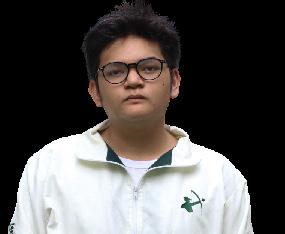
By EJ De Guzman
As naturalized winter athletes step into the limelight, hoisting the nation’s colors, local talents once filled with dreams and hopes are left standing on the sidelines while their efforts wither away quietly in the face of neglect and mismanagement.
Naturalizing athletes, especially in winter sports, continues to put the nation on the world’s biggest stage. Notably, the Philippine Olympic Committee has made significant moves in winter sports, producing speed skating prodigy Peter Groseclose and alpine skier Asa Miller.
The country’s roster was further bulked on December 20, when President Ferdinand Marcos Jr. officially signed Republic Act 12115, granting Russian figure skater Aleksandr Korovin Filipino citizenship in an attempt to enhance the Philippines’ performance in this year’s Winter Asian Games in Harbin, China, and the upcoming 2026 Milan-Cortina Winter Olympics— events where the tropical nation has historically struggled to make its mark.
While it is commendable to witness winter athletes emerge and succeed from a tropical country, one must question why Filipino hopefuls, particularly in figure skating, continue to be overlooked.
For years, the global stage has witnessed the boundless talent of Filipino athletes. Former Winter Olympian Michael Martinez exemplified this in 2014, becoming the first Southeast Asian to qualify for the Olympic free skate, followed by his victory at the Asian Figure Skating Trophy the following year.
Despite his stellar showing, Martinez—who planned a comeback for the 2022 Olympics—became another casualty of the systemic neglect that continues to plague local athletes. Training in the United States, the acclaimed figure skater had to publicly solicit funds to continue pursuing his dream of returning to the sport he holds close to his heart.
This recurring pattern of neglect is not unique to figure skating but extends across many sports. The government’s reliance on recruiting foreign athletes is merely a band-aid solution to a deeper problem: the absence of long-term investment in developing local athletes through grassroots programs and the lack of opportunities for international exposure.
Though a difficult pill to swallow for local athletes in the present, it is undeniable that the expertise of Korovin and the like is a crucial step in helping the sport progress for future local athletes, such as the case with Chinese snowboarder Eileen Gu, whose success has inspired the next generation of dreamers in the country she calls home.
Filipino athletes already possess the heart and grit to represent the nation with pride; what’s missing is the investment needed to transform their dreams into reality.
By Redentor Daniel Ulsano
After an endless voyage of ball crafts and shooting from far beyond the arc, they have finally retired their Green uniforms. As they embarked on the journey through the bloodthirsty PBA League, Justine Baltazar, Jonnel Policarpio, and Mark Nonoy packed up their bows to step up and introduce the might of the Green-and-White onto the grand stage of Philippine Basketball. Way before bearing the brunt, Baltazar was among the many kids who dedicated boundless grit for a chance to spread his wings. And as he did climb to the top, the man destined to raise the stakes was not always in the spotlight. With plentiful minutes from the benches tracing his story back even from prominent pace setters Ben Mbala and Jeron Teng, Baltazar indeed embodied patience—seeking another time to shine—and as it is, the 3-time Mythical Team qualifier of the University Athletic Association of the Philippines (UAAP) Season 81, 82, 84 got to banner his revelation, closing the chapter of his UAAP stint of silver: it has been no wonder that wunderkind Baltazar was chosen as the top pick overall for the Converge FiberXers.
But, really, the journey only began for the top rookie as he got slammed to the dust in his debut—a first impression that raised eyebrowsleft eyebrows perplexed. Baltazar was supposed to be the future of Philippine Basketball, and he proved as is. He recently spearheaded a career-high doubledouble in a match over Blackwater Bossing—a glimpse of the heights he is destined to reach.
For the glory of La Salle, Policarpio led the Greenand-White to two UAAP championship titles. Facing his
family’s financial agitation led to his abrupt application for the PBA: a fretting decision, yet he nailed it as the 6th pick for the NLEX Road Warriors. Leaving La Salle was unexpected; however, it left trails that would make the world brighter: ‘family first’—reflecting his Lasallian values.
Fighting againstFiring all odds, he endeavored the upper first impression: his debut with trumpets sounding on their side. The cries for success were heard; with his recent trailblazer performance taking on the Phoenix Fuel Masters, copping 17 markers, inspiration towards him entailed as his Lasallian values prevailed.
Having been blessed with swift athleticism, Nonoy had his uphill battle after his first and last season to distinguish his worth as a Green Archer. And he did. Winning the UAAP Season 86 championships. With this exceptional feat, being selected as the 10th pick for the Terrafirma Dyip was no less than what was expected.
Unfortunately, his rookie season was struck by a wound unhurried to heal, being winless at the beginning. But redemption was not a stranger to the Green-blooded point guard But that only meant a motivation for redemption; in his lone win, the top team, TNT Tropang Giga, dwindled in the sight of the Green Flash staggering historic 33 points.
From diamonds in the rough to polished prospects, these three athletes act as a benchmark for La Salle’s primeadmirable basketball program. As they sustain the flame of greatness, they continue to breathe life into the legacy: to reshape the future of Philippine basketball—a future where the best is yet to come.
By Marian Gonzales
Fresh off a silver finish in the UAAP Season 86 Baseball Tournament, the De La Salle University (DLSU) Green Batters proved they could keep up with the pros, with several standouts from the team’s roster stepping up to the plate in the Philippine Men’s Baseball Team’s defense of the country’s fifth consecutive BFA XIV East Asia Baseball Cup title, anchoring the squad’s undefeated campaign from October 29 to November 3 at the Clark International Sports Complex in Pampanga.
With a five-peat on its hands, the Philippines reasserted its dominance in the East Asia Cup through a five-game sweep against neighboring countries Hong Kong, Indonesia, Singapore, Thailand, and Cambodia amidst huge expectations of securing the title on home soil in front of an enthusiastic Filipino crowd that filled the venue until the final.
DLSU star player Lord Aragorn De Vera earned a spot on the All-Star Team and was named Best Shortstop and Most Outstanding Defensive Player of the tournament after posting a game-high 16 assists, a 0.444 batting average (BA), and six runs batted in (RBI). Meanwhile, DLSU catcher Renato Samuel Jr. tallied a 0.250 BA. Joining the two was former DLSU-bred star Joshua Pineda, while on the bench was DLSU baseball legend former and current head coach Joseph Orillana.
The Green-and-White’s strong presence in the tournament solidifies its continued ground in developing top-tier baseball talent, not just in its players but in the champions who come back to build the future. The achievements of its athletes, whose impact extends not only to collegiate grounds but to international levels, further reinforce its reputation as a key pipeline for the sport’s growth in the country.
There is no place like home; for Joseph Orillana, home has always been DLSU. A legend on the diamond, Orillana’s legacy as a Green Batter was built on championships and accolades—two UAAP titles, an MVP trophy, multiple Best Pitcher awards, and recognition as Student-Athlete of the Year. After his collegiate career, he

to ashes before giving it the spark it needs?
The Philippines has always been a nation driven by its love for sports, where every game ignites a deep passion. However, as funding dwindles, that fire begins to flicker, and the dreams of countless athletes start to fade. With less support, more and more athletes struggle to hold onto the love they once had for the game.
For decades, the fight for funding has been an alltoo-familiar story in Philippine sports. Despite Filipino athletes rising to extraordinary heights on the global stage, the issue remains unchanged. The government proudly claims credit for these victories, yet when the time comes to invest in preparation, their promises fall short.
Take the 2020 Tokyo Olympics, where weightlifter Hidilyn Diaz, who brought home the country’s firstever Olympic gold, revealed that she had to battle financial hardships just to secure the resources needed to compete. When she spoke out, instead of receiving support, she faced backlash—branded as ungrateful and accused of disrespecting the nation’s supposed aid. She was even red-tagged, enduring political persecution simply for exposing the harsh realities that nearly denied her the chance to achieve history.
The struggle persists. In 2023, pole vaulter EJ Obiena disclosed that his team had gone unpaid for an entire year, leaving his frustrated coaches on the verge of pulling out. Now, the crisis deepens as the Philippine government slashes the sports budget by ₱725 million for 2025, cutting it from ₱1.156 billion in 2024. This drastic reduction only tightens the financial chokehold on Filipino athletes, forcing them to battle not just their opponents but the suffocating lack of resources that threaten to shatter their dreams. Generations of athletes have endured this cycle of neglect, and political exploitation within the Philippine Sports Commission (PSC) continues to block vital support, trapping the country in a loop of underachievement.
carried his talents to the national team, helping the Philippines climb to the top of multiple international stages. But despite this, his heart remained with La Salle. Trading his glove for a clipboard, the former batter returned to Taft as a coach, determined to pass on the responsibility of winning to the next generation.
As a cornerstone for both La Salle and the Philippine Men’s Baseball Team, Lord Aragon De Vera is among the sport’s elite, a distinction he still holds today. In June 2024, the starting shortstop received an invitation for a workout with Major League Baseball team Arizona Diamondbacks in the United States—an opportunity never before offered to a Filipino athlete. His impressive performance at the East Asia Cup further added to his momentum as a standout for both DLSU and the national team, as he continues to push the sport’s growth and the team’s aspirations to compete at even higher levels in the coming years.
Looking ahead to UAAP Season 87, the Green Batters are determined to build on this momentum. With these pillars driving the team forward on and off the field, DLSU is well-positioned to reclaim the UAAP championship and bring the title back to Taft.
As the saying goes, “No man is an island.” Baseball takes a team to win, and with players trained, goals set, and bats in hand, there is no doubt that the team’s aspirations to reclaim the UAAP throne remain as clear as ever.

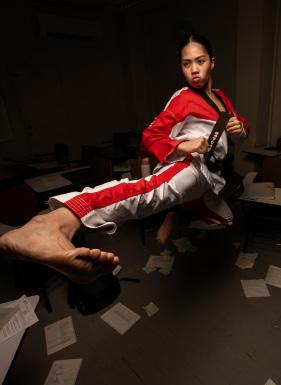
Without the proper support, the flame of passion for sports in the country risks burning out. As funding continues to shrink, athletes are left to fight not just for victories, but for survival in their fields. Without intervention, the spark that once fueled their dreams may vanish, leaving behind only the ashes of what could have been.
When the passion fades, it’s no longer just a game—it’s game over.
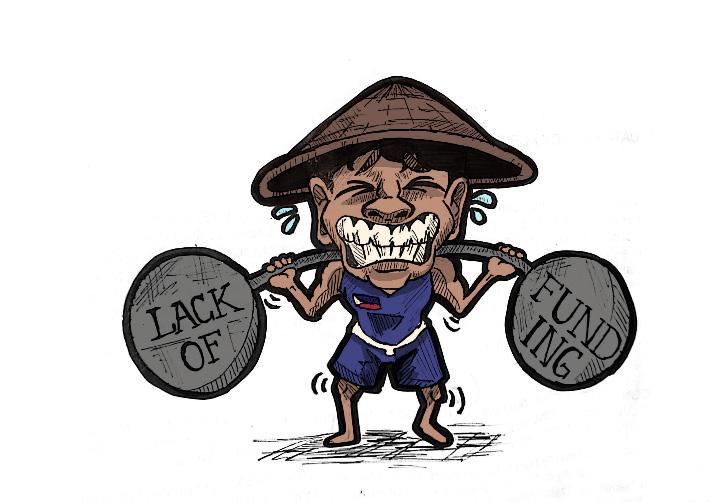
With every powerful kick, Allyah Eusalan has evolved from a young hopeful to one of De La Salle University’s (DLSU) brightest stars in Philippine taekwondo. Each strike she lands is more than just a victory but an attestation to years of dedication and perseverance. Her recent triumph at the 2025 MVP Sports Foundation National Team Selection marks the culmination of her hard work, solidifying her position as a top contender for the Philippine Taekwondo National Team.
With her sights firmly set on securing a coveted spot on the national team, Eusalan has tirelessly honed her skills in preparation for the 2025 MVP Sports Foundation National Team Selection. During the recent UAAP Season 87 taekwondo tournament, she helped maintain DLSU’s dominance by contributing to the team’s third-place finish, securing a bronze medal in her individual event. This achievement underscored not only her skill but also her commitment to bringing pride to herself and to the university.
Eusalan’s dedication to her craft is evident in her steady rise in a sport to which she has committed herself. In 2019, the Filipina jin made a significant mark by clinching a gold medal in the Light Heavyweight Division at the Palarong Pambansa and a bronze at the Western Visayas Regional Athletic Association (WVRAA). These early victories not only showcased her potential but also fueled her relentless drive to overcome challenges and reach greater heights.
The road ahead for Eusalan is as promising as the victories she has already claimed. Yet, through all her successes, the young athlete message remains clear: greatness is earned, not given. With every strike and every challenge she conquers, Eusalan continues to cement her legacy—not just as a taekwondo champion but as an enduring inspiration for aspiring athletes in the country.


Defending champions Green Archers hoped for a Season 86 repeat, only to fall short in a bloodbath winnertakes-all finals against the redemption-hungry Fighting Maroons at the Smart Araneta Coliseum last December 15.
Last season, La Salle was the underdog, eager to end a decade-long title drought. This season, arrows were pointed at the backs of the Green-and-White as they fought to defend their hard-earned championship.
After a staggering 15-1 run in the eliminations and a commanding victory over the Soaring Falcons in the Final Four, the Archers faced one final mission: win two games against their new-age rivals.
“There’s always gonna be pressure, and you’re not gonna complain about being in this position,” Green Archers Head Coach Topex Robinson said in a pre-season interview.
With half of the Season 86 veterans gone, the team’s fate depended on how well they could fill the gaps left behind. The Fighting Maroons took this to their advantage as they put out a defensive powerhouse that forced turnovers on the Green Archers.
From a cleanup player who turned missed shots into
By Aaliyah Mallari
second chances, Quentin Millora-Brown transformed into an offensive madman, scoring his career-high 17 points alongside nine rebounds, three assists, and two steals, closing on DLSU’s big men from scoring from the paint, claiming Game 1 with a 73-65 victory.
Game 2 seemed firmly in the Fighting Maroons’ hands, with a seven-point lead halfway into the fourth quarter. But in true La Salle fashion, KQ delivered a wide-open threepointer in the final minute, snatching the lead.
Last-minute heroics are nothing new for the Taft-based team. In Game 3 of Season 86, La Salle trailed throughout but mounted a comeback in the fourth quarter to clinch the title. However, this season, UP maintained relentless pressure, keeping the defending champions on edge until the very end.
With QMB dominating the paint, the Green-and-White relied heavily on Quiambao as their primary scoring option.
In the second half of Game 1, Jacob Bayla pounded pressure on the season MVP, closing on two three-pointer opportunities for KQ and stunning DLSU with a lineup fortified by indestructible shields and heated guns. “They did a great job in stopping KQ,” Robinson admitted.
The absence of reliable shooters, such as Season 86 alums Evan Nelle and Mark Nonoy, significantly hampered the Green Archers’ ball rotation, allowing the Fighting Maroons to tighten their defense on Quiambao and Phillips.
“We know naman na if you’re gonna play against La Salle, the defense will be the one to win the game,” Fighting Maroons Head Coach Goldwin Monteverde emphasized after their Game 1 victory.
True to his words, UP’s stellar defense led by JD Cagulangan and an overpowering offense spearheaded by Francis Lopez were the keys to their redemption run, denying any clutch heroics from KQ to propel the Green Archers to a back-to-back championship.
“We played it until the final buzzer, and we did it the way how true Lasallians do it: we just kept on fighting,” Robinson assured.
Season 88 now begins a new chapter with the arrival of Jacob Cortez, Mason Amos, Kean Baclaan, and Luis Pablo.
The Green Archers hope to reclaim the throne and once again establish Taft as the home of the kings of UAAP Basketball.
By Christ John Yong
In the wake of their dominant win as the newly crowned Collegiate Center for Esports League Season 4 champions, Arcus secured the honor of representing the Philippines at Campus Game Fest 2024 after shooting down their UAAP rival, the Far Eastern University (FEU) Tamaraws, in a sweet 3-0 showdown.
Fueled with nothing but redemption, the Filipino gamers made sure vengeance would return after their first UAAP Mobile Legends tournament stint encountered a depressing blow, where they were cut short in a 1-1 tie against the FEU Tamaraws and the Ateneo de Manila University Blue Eagles.
Their strength came as no surprise, as Filipino esports pro Kent Xavier “Kevier” Lopez was no stranger to foreign battlegrounds. His tenure as a jungler for Blacklist International in MPL Philippines Season 9 provided a steady anchor for the team as they rambled on in their most anticipated event.
With all eyes on the Green-and-White gamers, the Land of Dawn witnessed a masterclass unfold as they geared up to herald their march to the finals. In Game 6, Arcus faced Vietnam’s UTHC in an early dominant showdown, with both teams refusing to give an inch, harvesting a tense 9-7 spree.
Capitalizing on an early game advantage, Aaron Joshua “aaronqt” Lim’s Gord led the charge, dealing devastating damage from all corners of Vietnam’s tanky lineup, and preventing any comeback from befalling as they went on dismantling the enemy nexus and ending with a 27-12 score by storm to qualify for the grand finals. Alas, glory became within arm’s reach as Arcus advanced to Game 1 of the grand finals against ITE in their home ground, Singapore. The Red Dragons found no escape as Arcus went on silencing their backline heroes through
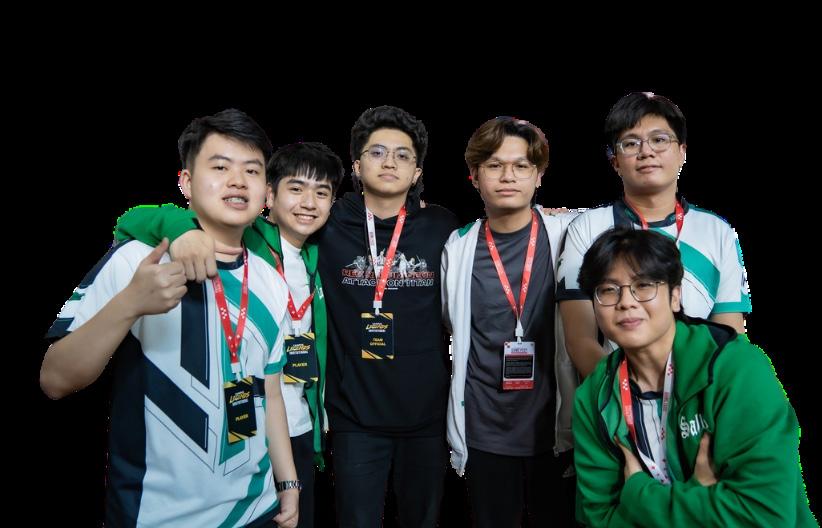
Joshua Nathaniel “Aspectzxc” Tating’s Hayabusa. Despite ITE’s sustain-heavy composition, the Filipino squad overwhelmed them with relentless aggression, securing a commanding 16-1 victory. For some, reaching the pinnacle of championship point is already more than enough, yet for Arcus, it was a bloodbath one way or another. Game 2 saw the stakes rise as Arcus faced Singapore’s signature crowd-control lineup. At the drop of a hat, roamer-legend aaronqt seized the opportunity and locked in Faramis, hoping to counter several tussles by the raging ITE’s heavy lineup. For both teams, it was a match that eclipsed beyond the game scene. Despite ITE’s desperate attempts to take hold of their ground, the Philippines remained unfazed. Even before the mid-game 12-minute mark, the battlefield was already in awe, witnessing a salvo of skills rain in from every hero as the tournament reached its climax.
“Victory!” yelled the game’s caster as the Philippines yet again clinched glory unscathed.
As the weight of the Game 2 triumph was taking hold, the Filipino athletes exhaled in relief after carrying the country’s flag with immense pressure. For Arcus, relentless confidence propelled the team to noble heights, proving once again that the Philippines is an undisputed powerhouse in the Land of Dawn. Their dominance not only solidified the country’s reputation in esports but also set the stage for DLSU’s continued rise in international and collegiate competitions.
With their sights now set on the upcoming UAAP Season 88 tournament, Viridis Arcus stands at the forefront of Philippine esports, ready to carve an even greater legacy.
By Kendra Renee San Jose
Exploding off the blocks, De La Salle University’s (DLSU) Bernalyn Bejoy gunned for glory and never looked back, crossing the finish line with two golds, one silver, and back-to-back MVP titles at the UAAP Season 87 Athletics Championships at the New Clark City Stadium in Capas, Tarlac from November 17 to 21, 2024.
The Negrense runner tore through the track with icecold composure, grabbing gold in both the 400-meter hurdles and 4x400-meter relay and chasing down silver in the 200-meter dash to seal her coveted MVP finish.
Blazing down the homestretch with laser focus, the track star charged the 400-meter hurdles with clockwork rhythm, powering through the final curve before unleashing a fullthrottle sprint to the finish line, stopping the clock at 1:00.53.
In the 4x400-meter relay, Bejoy anchored the dream team of Hannah Delotavo, Jessel Lumapas, and Erica Ruto, taking the baton on the final leg and storming ahead with clean strides to widen DLSU’s lead, closing it out at 3:47.37 for another golden finish.
Coming off her golden streak, the lady trackster settled into the blocks for the 200-meter event, firing out the curve and driving her knees down the straight, but as the pack closed in, she clocked 25.07, just 0.32 seconds off the gold, and leaned through the tape for a hard-fought silver, closing out Season 87 with three medals and a second straight MVP crown.
Before the lights of Season 87 crowned her once again, the Bacolod City native runner had already made her mark in Season 86, where she dominated both the 400 and 800-meter events to claim twin golds and capped her run with a bronze in the 200-meter event that helped DLSU bag the overall championship title.
With every stride, she controlled the tempo around the bends, attacked the hurdles with poise, and powered through the final stretch with a lethal kick that left the field chasing from behind.
Under the weight of a title chase and the glare of the spotlight, the Negrense standout owned the oval with a breakout performance that not only earned her first MVP plum but also stamped her name among the league’s elite,
setting the pace for the dominance she would return to build on a year later.
On the global stage, Bernalyn Bejoy thundered down the track in the Southeast Asian (SEA) Games, sprinting ahead of every runner in the 800 and 4x400-meter events, breaking a 30-year-old record and bagging a well-earned podium finish.
Coming out of the blocks with unmatched speed, the PH-bet stormed through the first 400 meters, maintaining a blistering pace as she dug deep into the backstretch, ultimately clocking an electrifying 2:09.20 to finish with a podium-worthy performance.
Anchoring the 4x400 meter relay, Bejoy teamed up with Robyn Brown, Jessel Lumapas, and Maureen Schrijvers, shattering a decades-old mark with a stunning time of 3:37.75, leaving their competitors in the dust.
Before making noise on the SEA Games stage and dominating UAAP, the Lasallian sprinter began her track career in local meets, sharpening her speed and form in the competitive lanes of Palarong Pambansa.
From early provincial stints to earning a spot on DLSU’s roster, she built her pace season by season, steadily carving her place among the league’s most explosive and consistent tracksters.
“You bring the flag on your chest,” she said. “I’m running not only for myself but for my country.”
As she continues to push boundaries with two MVP titles and a SEA Games record under her belt, Bernalyn Bejoy sets her sights on bigger battles ahead, proving that her run is far from over and the world has only just begun chasing her pace.




By Aaliyah Mallari
Team Asia cued in the first-ever victory against European veterans in the Inaugural Reyes Cup at the Ninoy Aquino Stadium from October 15 to 19.
Named in honor of the legendary figure who put the Philippines on the global pool stage, the tournament served as a long-overdue tribute to his unparalleled contributions to the sport. Inspired by the Mosconi Cup, the World Nine Ball Tour established the Reyes Cup to showcase Asia’s finest talents against their European counterparts.
Reyes, the “Magician,” stepped into the role of nonplaying captain, guiding the new generation of Asian pool players in rising to the challenge, vying to be the first team to win 11 out of 21 matches.
Despite entering as the underdogs in the tournament, Europe had to play catch up in the series. The strong push from Team Asia began early, setting the pace with a 3-2 victory on the first day, while Europe struggled to gain ground. As the tournament progressed, the European veterans found themselves unable to secure a lead, falling behind by the five-day mark.
The Asian team stood their ground and reigned
supreme despite a sudden change in momentum on the final day. Europe’s attempts to hold on with a 4-0 match run were too late, as Asia was one match away from clinching the victory.
Aloysius Yapp was at his best during the tourney and closed out in peak form on the final to win his side an 11-6 victory, his performance worthy of securing the cup’s MVP honors.
“I’ve been waiting for this for so long. Ever since the founding of the Mosconi Cup, I’ve wanted something for Asia,” Reyes shared during a press conference, reflecting on the long-awaited realization of his vision.
The victory of Team Asia in the inaugural Reyes Cup reignited the nation’s fire for pool, with the electric atmosphere in the stadium and the overwhelming passion for the sport fueling Filipino pride in every corner of the venue.
As the legend hangs his cue stick, the path he paved is now being taken by the next generation of Filipino champions. The Reyes Cup is a homage to the legend— not just in the Philippines, but in the global pool scene— elevating the sport from an after-school pastime to the professional stage it commands today.

